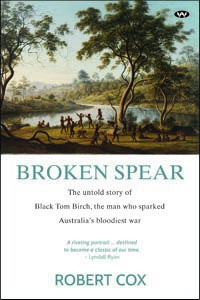This page of the Australian Frontier Conflicts website includes summaries of selected and new books, in year order–the most recent first, which deal with conflicts, killings, massacres and wars that occurred in the colonial period from 1788 to the 1940s. Books included below are available at good libraries. Most are still available to purchase in print and some as e-books. You can check availability by searching online by author and title. Ever-growing lists of publications on Australian frontier conflicts listed on this website are included in the Bibliography and in Journal Articles. Growing lists of databases, films, podcasts and videos, related to colonial frontier conflicts, are also included under Resources on the main menu. This Books page, like the whole website, is still being developed. New material is added as time and technological hurdles permit, so come back to visit.
2025
 |
Kate Grenville, Unsettled: A journey through time and space, Black Inc. 2025
The disturbing. non-fiction account of the author’s family history at Wiseman’s Ferry, near Sydney, New South Wales. |
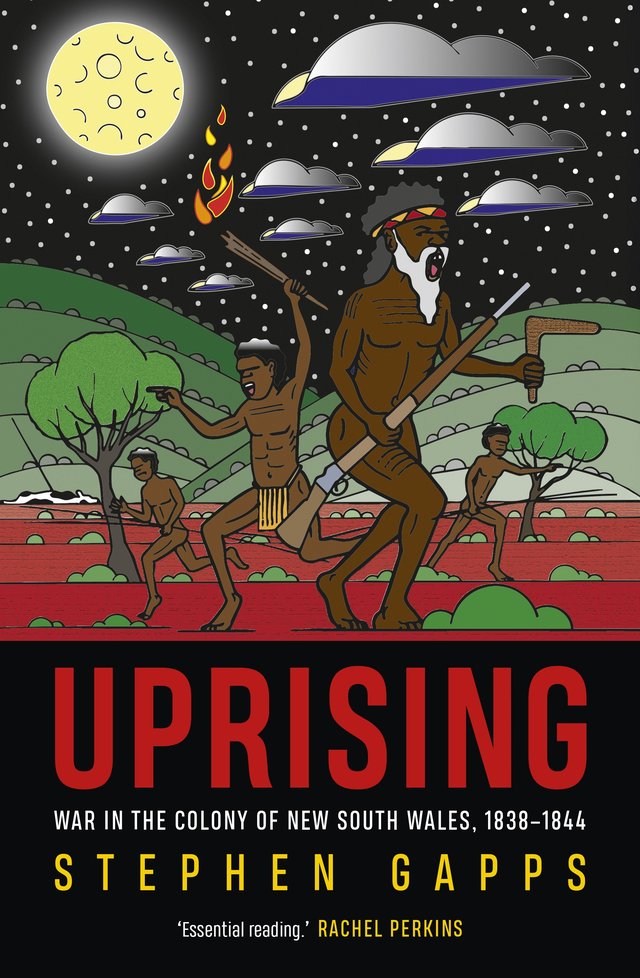 |
Stephen Gapps, Uprising: War in the Colony of New South Wales, 1838–1844, New South Publishing, 2025
‘The award-winning author of The Sydney Wars reveals the breadth of frontier resistance warfare. |
2024
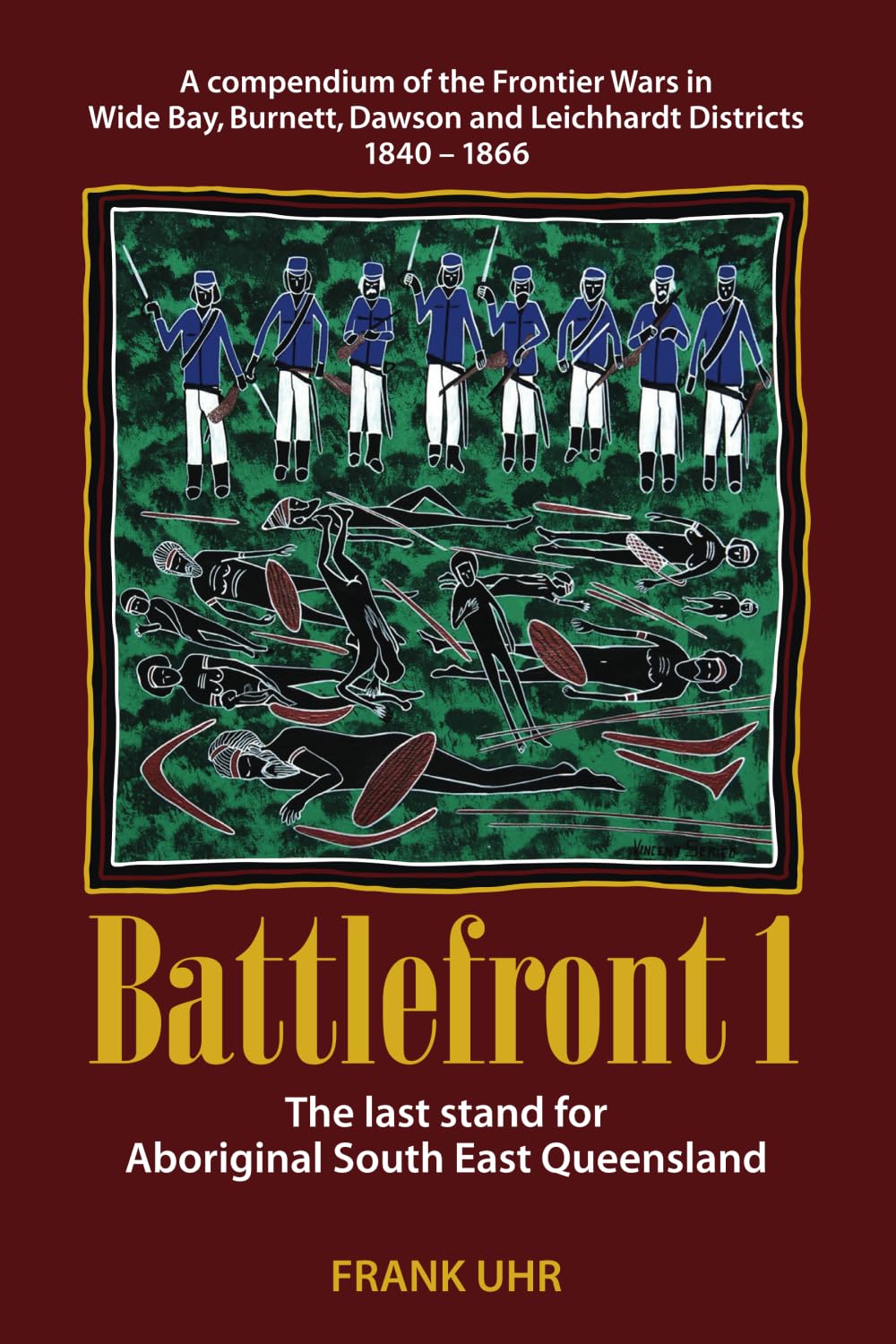 Version 1.0.0 |
Frank Uhr, Battle Front 1: The last stand for Aboriginal South East Queensland: A compendium of the Frontier Wars in Wide Bay, Burnett, Dawson and Leichhardt Districts, 1840–1866, Amazon, 4 December 2024
‘Battlefront 1: The last stand for Aboriginal South East Queensland: This is the first in a series of books titled Battlefront that delve into the history of frontier conflict, the often violent fight for the control of grazing lands and waterways, and the wars that ensued between Aboriginals and Squatters in Queensland.’ Amazon |
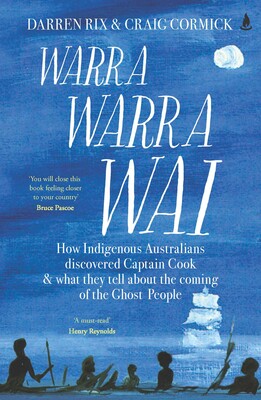 |
Darren Rix and Craig Cormick, Warra Warra Wai: How Indigenous Australians discovered Captain Cook, and what they tell about the coming of the Ghost People, Scribner, an imprint of Simon & Schuster, September 2024
‘For the first time, the First Nations story of Cook’s arrival, and what blackfellas want everyone to know about the coming of Europeans. Both 250 years late and extremely timely, this is an account of what First Nations people saw and felt when James Cook navigated their shores in 1770. We know the European story from diaries, journals and letters. For the first time, this is the other side. Who were the people watching the Endeavour sail by? How did they understand their world and what sense did they make of this strange vision? And what was the impact of these first encounters with Europeans? The answers lie in tales passed down from 1770 and in truth-telling of the often more brutal engagements that followed. Darren Rix (a Gunditjmara-GunaiKurnai man, radio reporter and Archie Roach’s nephew) and his co-author Craig Cormick travelled to all the places on the east coast that were renamed by Cook, and listened to people’s stories. With their permission, these stories have been woven together with the European accounts and placed in their deeper context: the places Cook named already had names; the places he ‘discovered’ already had peoples and stories stretching back before time; and although Cook sailed on, the empire he represented impacted the people’s lives and lands immeasurably in the years after. ‘Warra Warra Wai’ was the expression called to Cook and his crew when they tried to make landfall in Botany Bay. It has long been interpreted as ‘Go away’, but is perhaps more accurately translated as ‘You are all dead spirits’. In adding the First Nations version of these first encounters to the story of Australian history, this is a book that will sit on Australian shelves alongside Cook’s Journals, Dark Emu and The Fatal Shore as one of our foundational texts.’ Simon & Schuster |
| Cover not available. | Robyn Smith, Licence to Kill: Massacre men of Australia’s north, Historical Society of the Northern Territory inc., 2024
‘Dr Robyn Smith, the author, is a lecturer in colonial history at Charles Darwin University and a conjoint lecturer at the University of Newcastle. The book is a forensic account of violent frontier expansion across Australia’s north with particular emphasis on the Northern Territory. Robyn reveals not only the perpetrators of massacres but their benefactors and enablers. She demonstrates how colonialism was subtly perpetuated by the conferral of high civic honour on many of the actors, noting that these are embedded as place names across the landscape.’ |
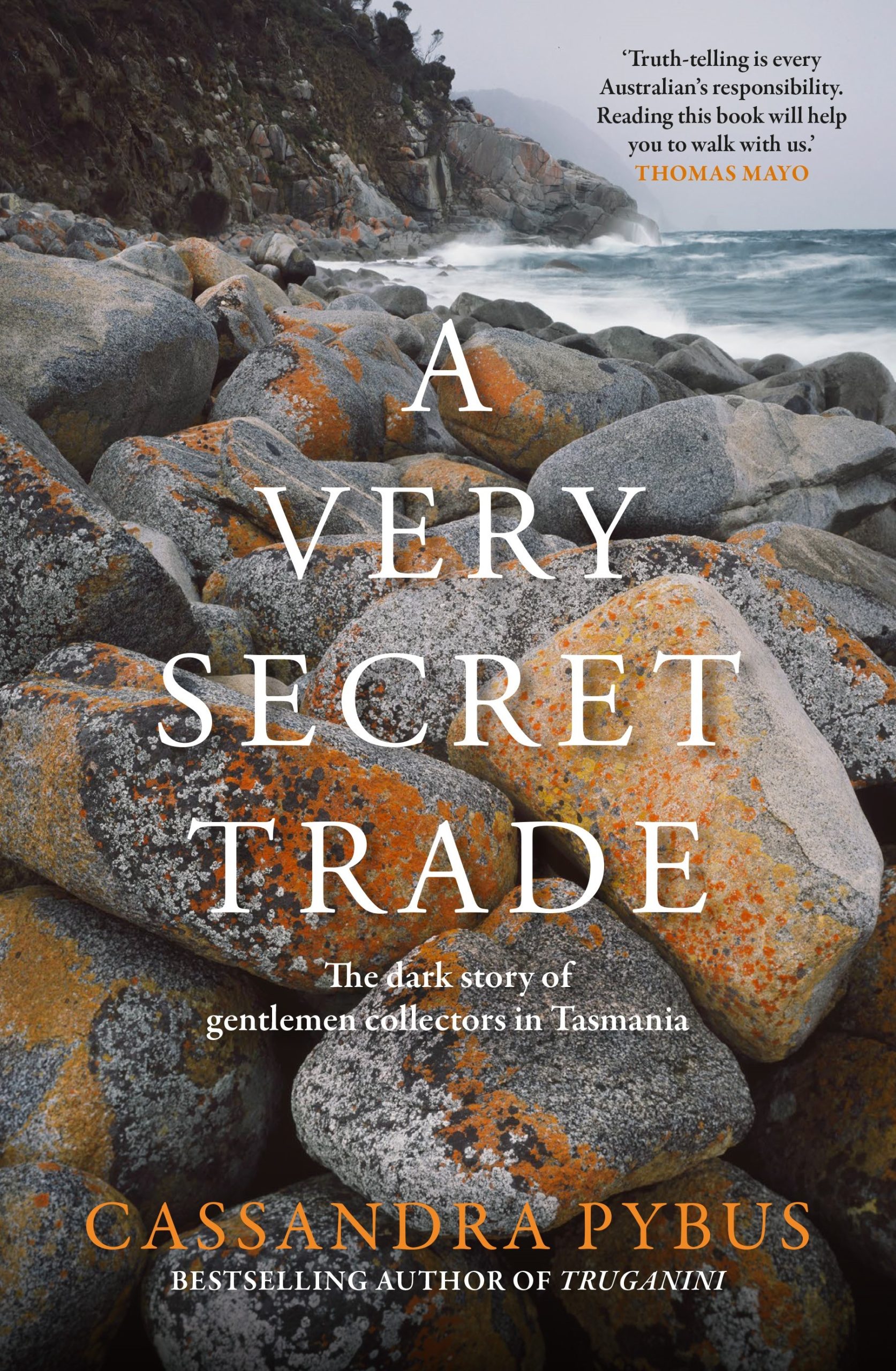 |
Cassandra Pybus, A Very Secret Trade: The dark story of gentlemen collectors in Tasmania, Allen & Unwin, 2024
‘Author of the bestselling Truganini, Cassandra Pybus has uncovered one of the darkest and best kept secrets in Australian colonial history. In the nineteenth century, collectors and museum curators in Europe were fascinated by the antipodean colony of Tasmania. They cultivated contacts in the colony who could supply them with exotic specimens, including skeletons of the thylacine and the platypus. But they were not just interested in animals and plants. The belief that the original people of the colony were an utterly unique race and facing possible extinction had the European scientific community scrambling for human exhibits. Many eminent colonial figures were involved in this clandestine trade, among them four colonial governors, several key politicians and even Lady Jane Franklin. In Britain, Sir Joseph Banks, the Duke of Newcastle and Professor Thomas Huxley were among many eminent men who solicited human specimens from the colony. Worse still, the men responsible for the care and protection of the few original people who had survived the ravages of disease and the infamous Black Wars were prominent in the trade. Cassandra Pybus has uncovered one of the darkest and most carefully hidden secrets in Australia’s colonial history. It is time we all knew the truth. “Truth-telling is every Australian’s responsibility. Reading this book will help you to walk with us.” – Thomas Mayo “A deeply ethical, and deeply disturbing, historical reckoning – a model of truth-telling for white Australians. In spell-binding prose, Cassandra Pybus reveals the continuing legacies of colonial dispossession …”- Professor Warwick Anderson “Exhaustively researched and arrestingly told” – Professor Mark McKenna’ |
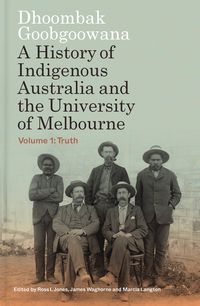 |
Ross L Jones, James Waghorne, Marcia Langton, Dhoombak Goobgoowana: A History of Indigenous Australia and the University of Melbourne, Vol. 1, Truth, MUP, 2024
Three versions: ebook (Free 28 May 2024), Hardback ($ July 2024) and Paperback ($ August 2024). See MUP: https://www.mup.com.au/search?query=Dhoombak for purchase details. ‘Melbourne’s oldest university confronts its long, complex and troubled relationship with the Indigenous people of Australia.
Dhoombak Goobgoowana acknowledges and publicly addresses the long, complex and troubled relationship between the Indigenous people of Australia and the University of Melbourne. It is a book about race and how it has been constructed by academics in the University. It is also about power and how academics have wielded it and justified its use against Indigenous populations, and about knowledge, especially the Indigenous knowledge that silently contributed to many early research projects and collection endeavours. By appropriating Wurundjeri land for its buildings, and accepting donations drawn from the proceeds of colonisation of Indigenous Country, the University of Melbourne advertised its superiority as a whole institution to Indigenous people. Within its buildings, academics and students explored a worldview that effectively banished Indigenous knowledge and culture. The University has supported injustices called progress, half-truths presented as facts, and prejudices pretending at objectivity. It follows the failings of many biographies and institutional histories that excluded race from their stories of achievement, overlooking how racist ideas complicated and shaped their narratives. Although many things have changed, the stain of the past remains. But the University no longer wishes to look away. Dhoombak Goobgoowana can be translated as ‘truth-telling’ in the Woi Wurrung language of the Wurundjeri Woi Wurrung people on whose unceded lands several University of Melbourne campuses are located. The cover photograph shows the members of a 1901 expedition through central Australia led by Frank Gillen (seated, left) and Baldwin Spencer (seated, right). To the rear stands mounted constable Harry Chance. Beside these white men are two Arrernte men, Erlikilyika (to the left) and Purunda (to the right). This image has been chosen to represent the unacknowledged participation of Indigenous people in the activities of academics in the University’s history. The uncredited work of Erlikilyika as interpreter of both language and culture informed many of the conclusions of the white ethnographers and the anthropologists who followed. The expedition would have been impossible without the knowledge of these Indigenous men, and the scholarship it produced exists only because of them. Ross L Jones‘ |
2023
 |
David Marr, Killing for Country: A Family Story, Black Inc., 3 October 2023
‘A gripping reckoning with the bloody history of Australia’s frontier wars David Marr was shocked to discover forebears who served with the brutal Native Police in the bloodiest years on the frontier. Killing for Country is the result – a soul-searching Australian history. This is a richly detailed saga of politics and power in the colonial world – of land seized, fortunes made and lost, and the violence let loose as squatters and their allies fought for possession of the country – a war still unresolved in today’s Australia. “This book is more than a personal reckoning with Marr’s forebears and their crimes. It is an account of an Australian war fought here in our own country, with names, dates, crimes, body counts and the ghastly, remorseless views of the ‘settlers’. Thank you, David.”—Marcia Langton’ Black Inc. |
 |
Marguerita Stephens with Fay Stewart-Muir
The Years of Terror Banbu-Deen: Kulin and Colonists at Port Phillip 1835–1851, Australian Scholarly Publishing, 10 August 2023 |
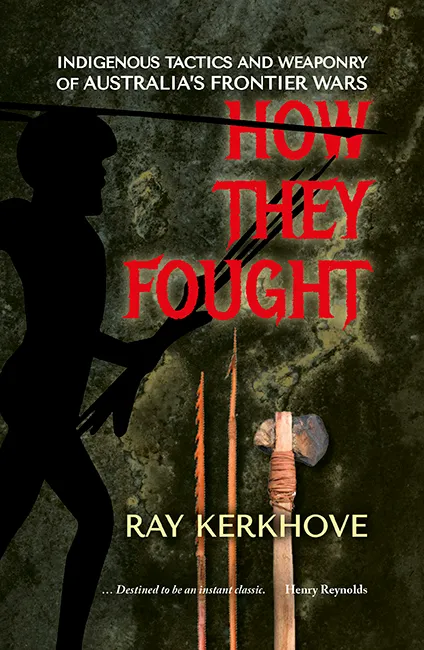 |
Ray Kerkhove, How They Fought: Indigenous Tactics and Weaponry of Australia’s Frontier Wars, Boonarong Press, 2023
‘The history of Australia’s Frontier Wars is becoming a hot topic for debate and research. It is now part of our national educational syllabus. However, there are very few books available that explain, in detail, the modes of warfare First Australians applied during the Frontier Wars. (See also the online Policy Journal, Pearls and Irritations for Dr Kerhove’s description of the book on 1 May 2023, under News, How (hard They Fought) How they Fought is written as an introductory guidebook. It is broken into chapters covering organisation, strategies, weaponry, and defences. The book considers both traditional practices and technological and tactical adaptations. To make this complex topic more accessible, How they Fought includes numerous tables, figures and diagrams that illustrate and summarise the contents.’ Booktopia Industry Reviews (from Booktopia) |
 |
Kate Auty, O’Leary of the Underworld: The Untold Story of the Forrest River Massacre, Black Inc. Imprint: Latrobe University Press, 2023
‘A powerful investigation that reveals the deep injustices inflicted on Aboriginal people in the Kimberley in the 1920s In June 1926, a posse of police officers and white civilians murdered at least twenty Oombulgurri people at Forrest River in the Kimberley. After the massacre, a conspiracy of silence descended. Witnesses vanished. Charges against two of the officers were dropped for insufficient evidence. One of the massacre’s perpetrators was Bernard O’Leary, a former soldier whose land holding was known as “the underworld”. At the 1927 Royal Commission into the killings, O’Leary was portrayed by his lawyer as a simple honest backwoodsman who was framed. In this powerful account, Kate Auty argues that O’Leary was in fact “vicious, brazen and a bullshitter”, with “a propensity for brutality”. Although never charged, he played a leading role in the murders, and his duplicitous testimony thwarted the commission’s work. In electric prose, Auty depicts O’Leary as a merciless killer, while the apparatus that concealed his crimes is portrayed with great realism and clarity. Driven by both forensic and moral judgement, the book exposes the injustices embedded in Australian settlement history, and the culture of denial that has prevented truth-telling in this country. “A major contribution to the study of frontier massacres in Australia”—Lyndall Ryan’, Black Inc. |
2022
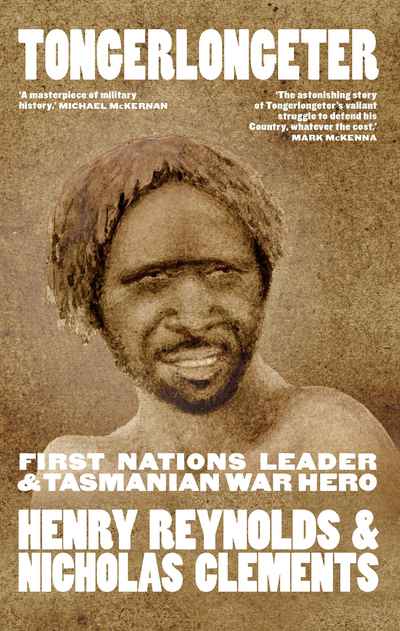 |
Henry Reynolds and Nicholas Clements, Tongerlongeter: First Nations Leader and Tasmanian War Hero: new edition, NewSouth Books, November 2022 (first published 2021)
“Henry Reynolds and Nicholas Clements uncover the extraordinary story of one of Australia’s greatest military leaders. Tongerlongeter is an epic story of resistance, sorrow and survival. Leader of the Oyster Bay nation of south-east Tasmania in the 1820s and ’30s, Tongerlongeter and his allies prosecuted the most effective frontier resistance ever mounted on Australian soil, inflicting some 354 casualties. His brilliant campaign inspired terror throughout the colony, forcing Governor George Arthur to counter with a massive military operation in 1830. Tongerlongeter escaped but the cumulative losses had taken their toll. On New Year’s Eve 1831, having lost his arm, his country, and all but 25 of his people, the chief agreed to an armistice. In exile on Flinders Island, Tongerlongeter united remnant tribes and became the settlement’s ‘King’ — a beacon of hope in a hopeless situation.” NewSouth Books |
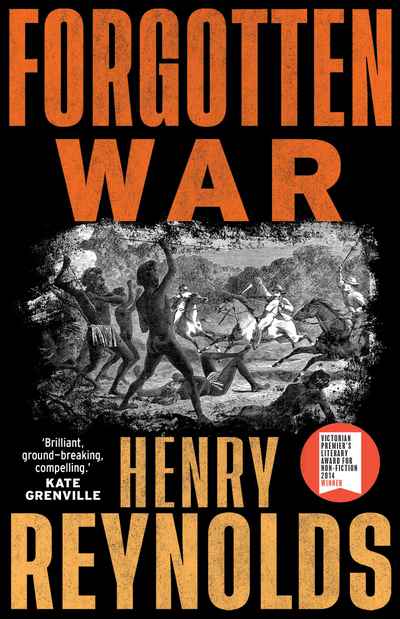 |
Henry Reynolds, Forgotten War: new edition, NewSouth Books, Sydney, July 2022
‘”We are at war with them,’ wrote a Tasmanian settler in 1831. ‘What we call their crime is what in a white man we should call patriotism.’ Australia is dotted with memorials to soldiers who fought in wars overseas. So why are there no official memorials or commemorations of the wars that were fought on Australian soil between First Nations people and white colonists? Why is it more controversial to talk about the frontier wars now than it was one hundred years ago? In this updated edition of Forgotten War, winner of the 2014 Victorian Premier’s Award for non-fiction, influential historian Henry Reynolds makes it clear that there can be no reconciliation without acknowledging the wars fought on our own soil.’ NewSouth Books |
 |
Dean Ashenden Telling Tennant’s Story: The strange career of the great Australian silence, Black Inc., 2022 “Tennant Creek and Australia’s Unresolved Past Returning after fifty years to the frontier town where he lived as a boy, Dean Ashenden finds Tennant Creek transformed, but its silence about the past still mostly intact. In a riveting combination of memoir, reportage and political and intellectual history, Ashenden traces the strange career of the great Australian silence – from its beginnings in the first encounters of black and white, through the work of the early anthropologists, the historians and the courts in landmark cases about land rights and the Stolen Generations, to still-continuing controversy. In a moving finale, Ashenden goes back to Tennant Creek once more to meet for the first time some of his Aboriginal contemporaries, and to ask how the truths of Australia’s story can best be told.” Black Inc. |
2021
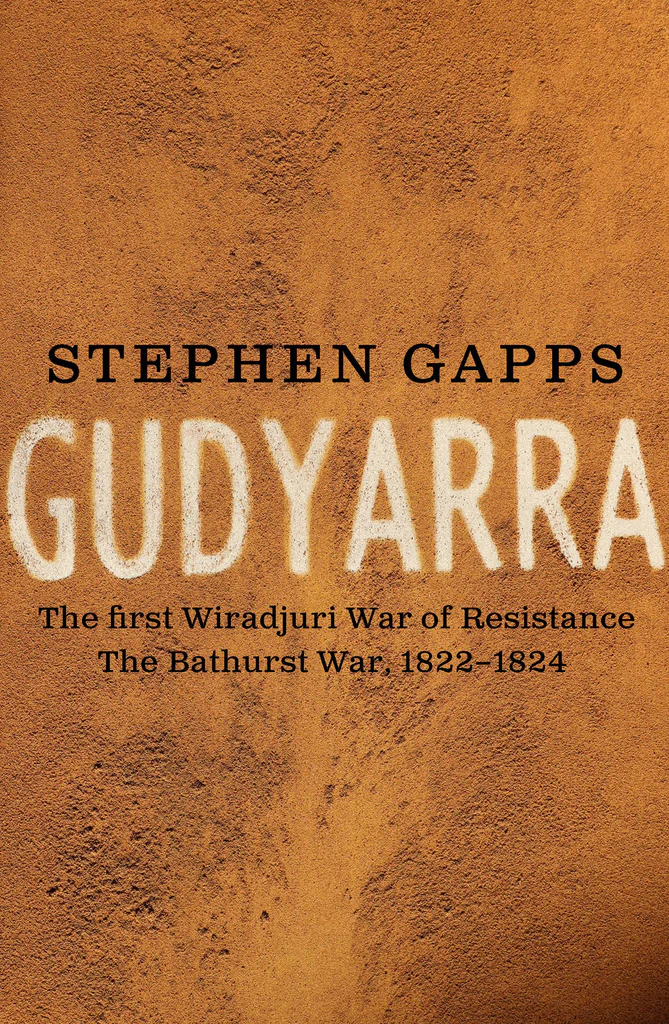 |
Stephen Gapps, Gudyarra: The first Wiradjuri War of Resistance, The Bathurst War, 1822–1824, NewSouth Books, November 2021
“In May 1824, what can only be described as a period of all-out, total gudyarra (‘war’ in the Wiradyuri language) had begun west of the Blue Mountains. Relations between Wiradyuri people and the colonists in the country around Bathurst had completely broken down, and the number of raids and killings occurring across isolated stock stations in the district had intensified.’ In Gudyarra, Stephen Gapps – award-winning author of The Sydney Wars – unearths what led to this furious and bloody war, beginning with the occupation of Wiradyuri lands by Europeans following Governor Macquarie’s push to expand the colony west over the Blue Mountains to generate wealth from sheep and cattle. Gudyarra traces the co-ordinated resistance warfare by the Wiradyuri under the leadership of Windradyne, and others such as Blucher and Jingler, that occurred in a vast area across the central west of New South Wales. Detailing the drastic counterattacks by the colonists and the punitive expeditions led by armed parties of colonists and convicts that often ended in massacres of Wiradyuri women and children, Gapps provides an important new historical account of the fierce Wiradyuri resistance. ‘This isn’t just a war for Wiradjuri country, this is a war for Australia: the country we are still to be. Our nation begins here.’ — Stan Grant ‘The untold story of the Wiradyuri War of resistance against a World Empire’ — Uncle Bill Allen Junior, Wiradyuri Elder ‘In Gudyarra, Stephen Gapps plots in meticulous detail the brutal war between the British and the Wiradyuri for possession of the Western Plains of New South Wales. A masterly account of both sides of the conflict, Gudyarra offers new understandings of the complexity of frontier history and the need for all Australians to reconcile with the past.’ — Lyndall Ryan ‘This is an important book, indeed essential reading for anyone wanting to understand the new direction in the history of the frontier wars.’ — Henry Reynolds”–NewSouth Books |
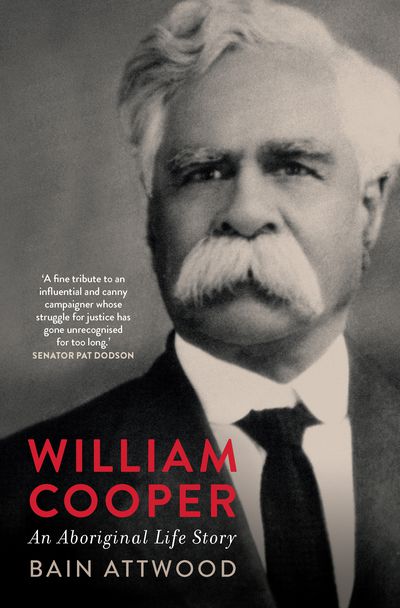 |
Bain Attwood, William Cooper: An Aboriginal Life Story, Melbourne University Press, November 2021 An important tribute to the work and life of an extraordinary Aboriginal activist.
“William Cooper’s passionate struggle against the dispossession of Aboriginal people and the denial of their rights and his heroic fight for them to become citizens in their own country has been widely commemorated and celebrated. By carefully reconstructing the historical losses his Yorta Yorta people suffered and endured, William Cooper: An Aboriginal Life Story reveals how the first seventy years of Cooper’s life inspired the remarkable political work he undertook in the 1930s. Focusing on Cooper’s most important campaigns-his famous petition to the British king George for an Aboriginal representative in the Australian parliament, his call for a day of mourning after 150 years of colonisation, the walk-off of the Yorta Yorta people from Cumeroogunga reserve in 1939 and his opposition to the establishment of an Aboriginal regiment in the Second World War-this carefully researched study sheds important new light on the long struggle that Indigenous people have fought to have the truth about Australia’s black history heard and win representation in Australia’s political order.” Melbourne University Publishing |
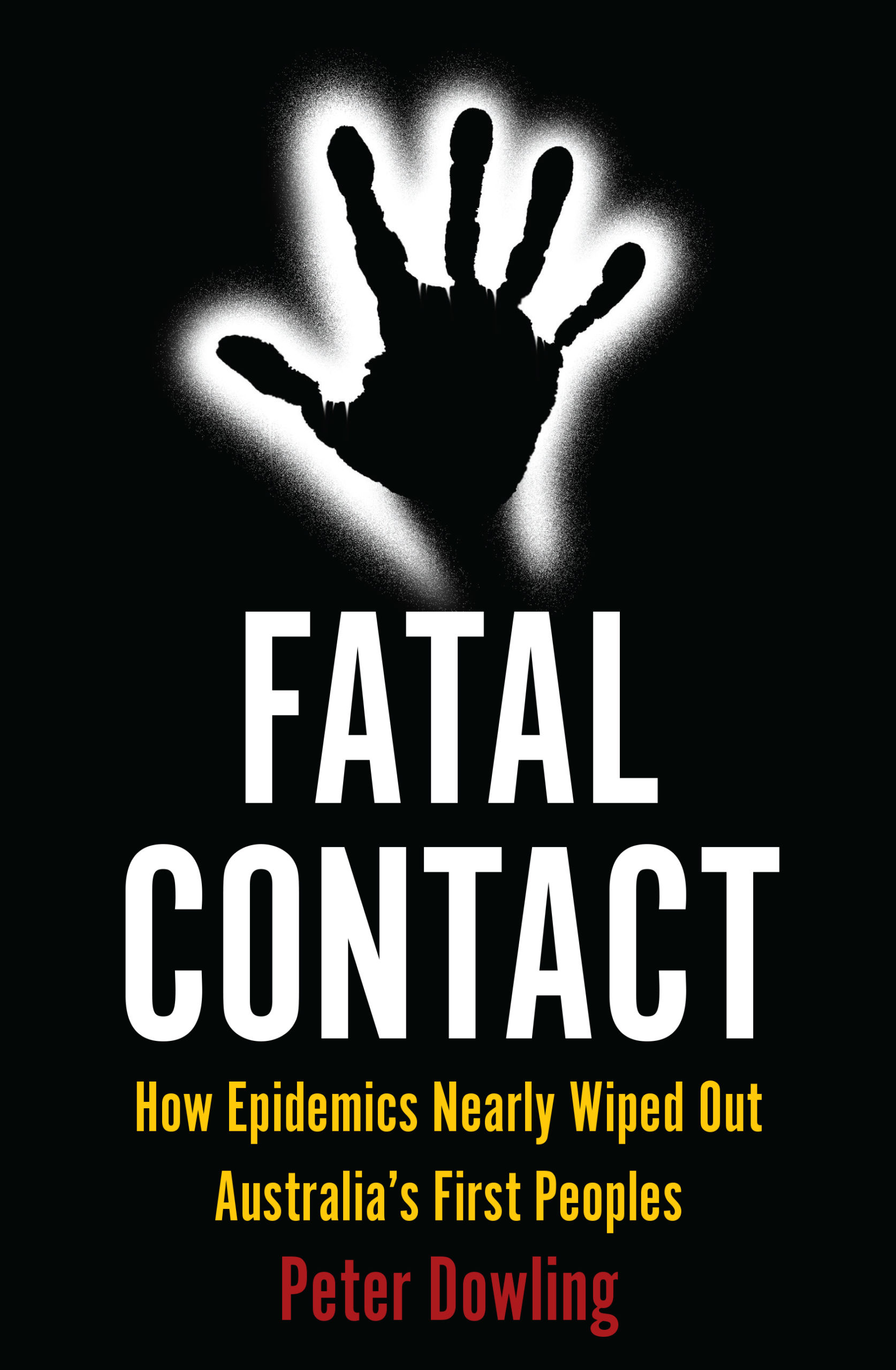 |
Peter Dowling, Fatal Contact: How Epidemics Nearly Wiped Out Australia’s First Peoples, Monash University Publishing, 2021“This book is about the devastating infectious disease epidemics which were introduced into the Indigenous populations of Australia after the arrival of the British colonists in 1788. Epidemics of smallpox, sexually transmitted diseases particularly syphilis and gonorrhoea, tuberculosis, influenza, measles swept through the indigenous populations of the continent well into the twentieth century the consequences of which still echo today in Aboriginal health and life expectancy.Many historians writing about the early colonial history of Australia have tended to acknowledge that introduced diseases caused much sickness and mortality among the Aboriginal populations and were part of the huge population decline following colonisation. But few of the writers have gone on to elaborate much further. Consequently, much of Australia’s history is missing, even after more than 200 years. Our knowledge and understanding of the biological consequences surrounding the meeting and contact of these two cultures has not yet been fully investigated.This book examines the major epidemics and explains the complexities of disease infection and immunology: which diseases were responsible for the Aboriginal population decline across Australia in the colonial period, when and where did they occur, how severe were they, how long did they last, which diseases were more devastating, and why were they so devastating? The author also focuses on the individual medical history of Truganini, the Tasmanian Aboriginal woman erroneously known as ‘the Last Tasmanian’. Focusing on the disease burden she faced during her life we can develop a deeper and personal understanding of how the First Nation Australians suffered and yet survived.What this investigation reveals is nothing short of the greatest human tragedy that has occurred in the long history of Australia. There can be little doubt in that, and it is a story that all Australians should read.” Monash University Publishing. |
|
|
Robert Cox, Broken Spear: The untold story of Black Tom Birch, the man who sparked Australia’s bloodiest war, Wakefield Press, 2021
‘Black Tom Birch was the most feared and hated man in Van Diemen’s Land. For four years he kept the colony in a state of terror. He was responsible for the deaths of dozens of settlers. He burnt their buildings and destroyed their livestock and crops. |
 |
Henry Reynolds and Nicholas Clements, Tongerlongeter: First Nations Leader and Tasmanian War Hero, NewSouth Books, 2021
‘An epic story of resistance, suffering and survival. Tongerlongeter resurrects a once-in-a-generation leader all Australians can admire. Australia has no war hero more impressive than Tongerlongeter. Leader of the Oyster Bay nation of south-east Tasmania in the 1820s and ’30s, he and his allies led the most effective frontier resistance ever mounted on Australian soil. They killed or wounded some 354 – or 4 per cent – of the invaders of their country. Tongerlongeter’s brilliant campaign inspired terror throughout the colony, forcing Governor George Arthur to launch a massive military operation in 1830 – the infamous Black Line. Tongerlongeter escaped but the cumulative losses had taken their toll. On New Year’s Eve 1831, having lost his arm, his country, and all but 25 of his people, the chief agreed to an armistice. In exile on Flinders Island, this revered warrior united most of the remnant tribes and became the settlement’s ‘King’ – a beacon of hope in a hopeless situation.’ |
 |
Jack Drake, Queensland’s Frontier Wars, Boolarong Press, Tingalpa, Queensland
‘Queensland’s Frontier Wars is an attempt to document the known confrontations between either white settlers or white and native police and First Nations people where deaths were reported. It is now an accepted premise that these confrontations were wars to gain access to the land, because, if not wars, then it was mass murder. No one in Queensland was charged with the murder of First Nations during these confrontations. The book shows the invasion from New South Wales into southern Queensland and the advances from the sea in central and north Queensland. The ‘dispersement’ of the First Nations people from their land was violent and efficient using far superior weaponry. This book adds significantly to the true and uncomfortable history of Queensland.’ Boolarong Press, Tingalpa, Queensland |
 |
Henry Reynolds, Truth-Telling: History, sovereignty and the Uluru Statement, New South Books, 2021
‘If we are to take seriously the need for telling the truth about our history, we must start at first principles. The historical record shows that the argument of the Uluru Statement from the Heart is stronger than many people imagine and the centuries-long legal position about British claims to the land far less imposing than it appears. In Truth-Telling, influential historian Henry Reynolds pulls the rug from legal and historical assumptions, with his usual sharp eye and rigour, in a book that’s about the present as much as the past. His work shows exactly why our national war memorial must acknowledge the frontier wars, why we must change the date of our national day, and why treaties are important. Most of all, it makes urgently clear that the Uluru Statement is no rhetorical flourish but carries the weight of history and law and gives us a map for the future.’ |
2020
 |
Grace Karskens, People of the River: Lost worlds of early AUSTRALIA, Allen & Unwin, Sydney, 2020
“A landmark history of Australia’s first successful settler farming area, which was on the Hawkesbury-Nepean River. Award-winning historian Grace Karskens uncovers the everyday lives of ordinary people in the early colony, both Aboriginal and British. Winner of the Prime Minister’s Award for Australian History 2021 Winner, Henry A. Wallace Award for Agricultural History 2020 ‘A masterpiece of historical writing that takes your breath away’ – Tom Griffiths Dyarubbin, the Hawkesbury-Nepean River, is where the two early Australias–ancient and modern–first collided. People of the River journeys into the lost worlds of the Aboriginal people and the settlers of Dyarubbin, both complex worlds with ancient roots. |
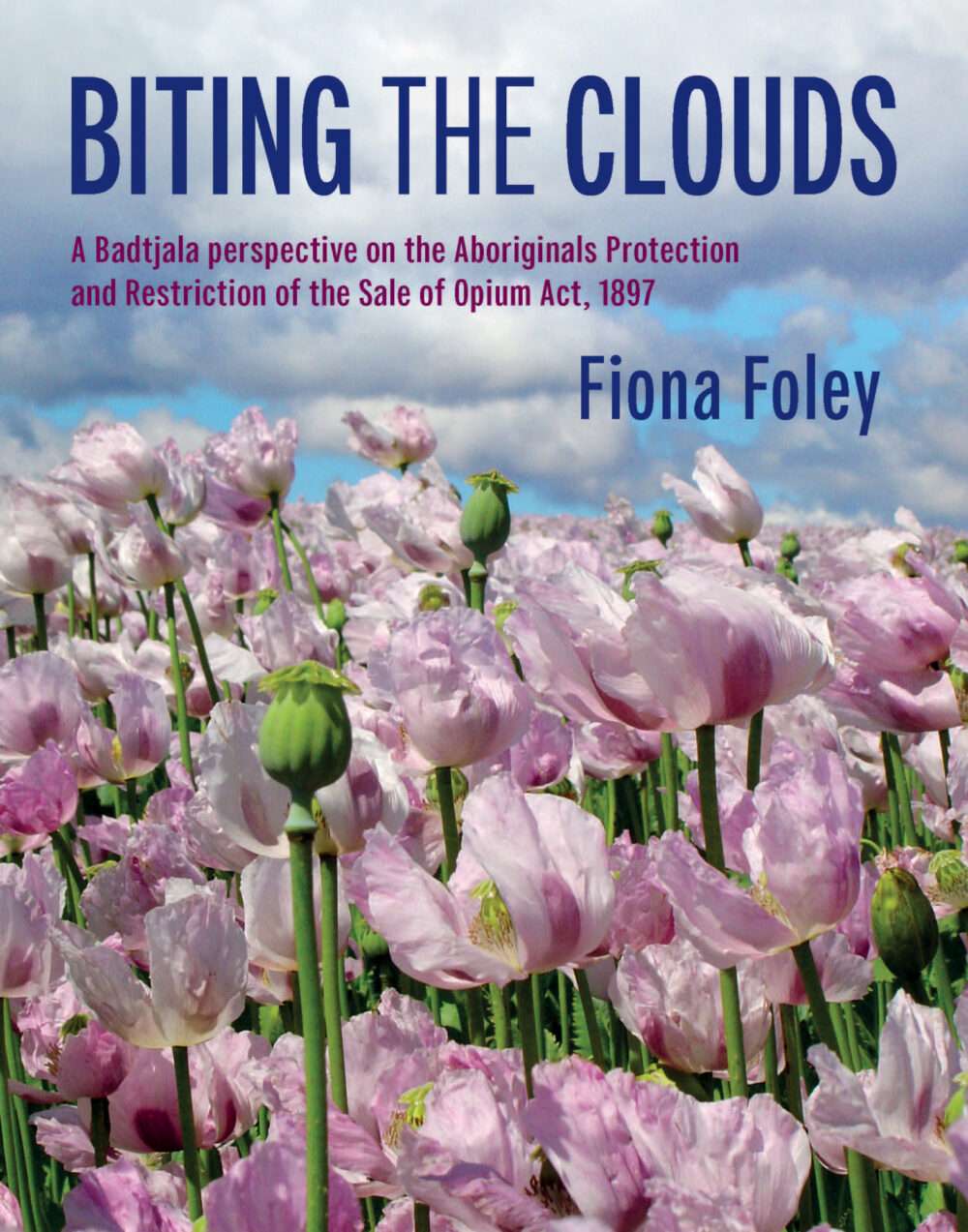 |
Fiona Foley
Biting the Clouds: A Badtjala perspective on the Aboriginals Protection and Restriction of the Sale of Opium Act, 1897, University of Queensland Press, 2020 ‘In this groundbreaking work of Indigenous scholarship, nationally renowned visual artist Fiona Foley addresses the inherent silences, errors and injustices from the perspective of her people, the Badtjala of K’gari (Fraser Island). She shines a critical light on the little-known colonial-era practice of paying Indigenous workers in opium and the ‘solution’ of then displacing them to K’gari. Biting the Clouds – a euphemism for being stoned on opium – combines historical, personal and cultural imagery to reclaim the Badtjala story from the colonisation narrative. Full-colour images of Foley’s artwork add further impact to this important examination of Australian history.’ |
 |
Mark Dunn
The Convict Valley: The Bloody Struggle on Australia’s Early Frontier, Allen & Unwin, 2020 ‘In 1790, five convicts escaped Sydney by boat and were swept ashore near present-day Newcastle. They were taken in by the Worimi people, given Aboriginal names and started families. Thus began a long and at times dramatic series of encounters between Aboriginal people and convicts in the second penal settlement in Australia. The fertile valley of the Hunter River was the first area outside the Sydney basin explored by the British, and it became one of the largest penal settlements. Today manicured lawns and prosperous vineyards hide the struggle, violence and toil of thousands of convicts who laid its foundations. The Convict Valley uncovers this rich colonial past, as well as the story of the original Aboriginal landholders. While there were friendships and alliances in the early years, in the later scramble for land in the 1820s–as the Valley was opened to free settlers–tensions rose and bloodshed ensued.’ |
 |
Cassandra Pybus Truganini: Journey through the apocalypse, Allen & Unwin, 2020 |
The author’s ancestors told a story about an old Aboriginal woman who used to walk across the Pybus farm on Bruny Island, Tasmania in the 1850s and 1860s. As a child, Cassandra Pybus did not know that this woman was Truganini and that she had every right to be walking over this country as it was that of her clan, the Nuenonne. Historian Cassandra Pybus has retraced Truganinni’s harrowing story from eyewitness accounts. Readers may not agree with all Pybus has written, however, this is an important book in the ever-growing literature on the conflicts that took place between Europeans and First Peoples in the Australian colonies.
2019
 |
Fred Cahir My Country All Gone The White Men Have Stolen It: the Invasion of Wadawurrung Country 1800–1870, Australian History Matters, Ballarat, Victoria 2019 |
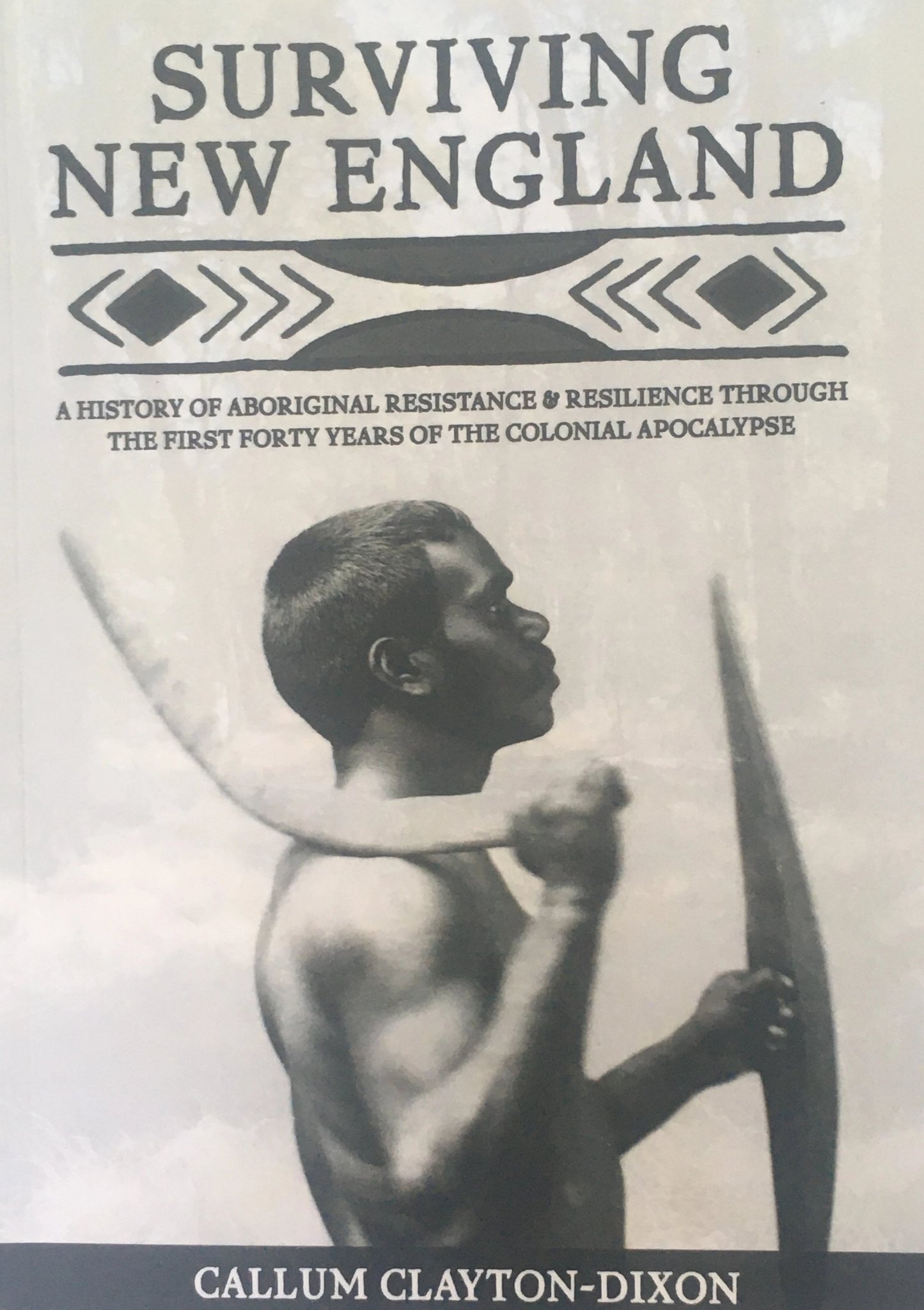 |
Callum Clayton-Dixon Surviving New England: A History of Aboriginal Resistance and Resilience Through the First Forty Years of the Colonial Apocalypse Anaiwan Language Revival Program, 2019’How do blak Nations get doing the heavy task of truth-telling? Surviving New England: A History of Aboriginal Resistance & Resilience through the First Forty Years of the Colonial Apocalypse offers us a model. Published by the Anaiwan Language Revival Program, produced entirely on Anaiwan Country and written by Ambēyaŋ linguist and historian Callum Clayton-Dixon, Surviving New England works towards a truth-telling that isn’t stuck in the colonial frame.The book is not a triumph — how could a history of anything so serious and enduring as colonisation be described as such? — but it is a remarkable and grounded work that should be cherished in its own right, and inspire similar projects. The account that Callum paints is through the archive of newspapers and government records, ‘[using] scattered historical records to reconstruct a coherent and detailed narrative of our people’s struggle for survival through the early colonial period.’It faces its core problem head-on — how do we use a colonial tool of memory to tell a story of colonisation for mob? Records might try to disguise the violence, justify it, or might omit it entirely.’ Alison Whittaker, IndigenousX: https://indigenousx.com.au/review-surviving-new-england/ |
 |
David Hill Convict Colony: The remarkable story of the fledgling settlement that survived against the odds Allen & Unwin, 2019The British colony of New South Wales, begun in 1788, is often thought of as founding colony of the successful ‘Lucky Country’. Well-known historian David Hill, once a Managing Director of the Australian Broadcasting Corporation, chairman of the Australian Football Association and chief executive of the New South Wales State Rail Authority, brings to light the story of how the colony nearly failed. To succeed, one of the main tasks of the colonists, associated military and militia was to dispossess Aboriginal people of their lands and resources. ‘Hostile’ Aboriginal people in New South Wales and other British colonies in Australia fought to save their lands, resources and cultures from the incursions of the newcomers. There were other dangers to the colonists such as lack of provisions, French and Spanish expeditions, and the convict uprising at Castle Hill near Sydney. The colony could have collapsed but survived, probably because of good luck, some good decisions and good British leaders. |
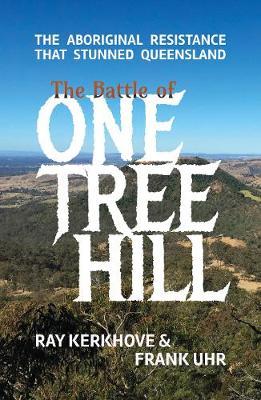 |
Ray Kerkhove and Frank Uhr The Battle of One Tree Hill: The Aboriginal Resistance That Stunned Queensland Boolarong Press, 2019’In 1840, Brisbane was the furthest outpost of settled Australia. On all sides, it was embedded in a richly Indigenous world. Over the next few years, mostly from across New South Wales northern plains, a large push of pastoralists thundered into the Darling Downs, Lockyer and much of southern Queensland – establishing huge sheep stations. The violence that erupted welded many of the tribal groups into an alliance that by 1842 was working to halt the advance. The Battle of One Tree Hill tells the story of one of the most audacious stands against this influx. It concerns actions engineered by a father and son, Moppy and Multuggerah. In 1843, this culminated in an ingenious ambush and one of the first solid defeats of white settlement in Queensland.The battle at Mount Tabletop, 128 kilometres west Brisbane, astounded many at the time. The response was most likely the largest action of the frontier wars: the assembly of some 100 or more officers, soldiers, police and armed settlers – much of the region’s white settlement – drawn from hundreds of square kilometres. These formed sorties to drive out the warriors, but despite their best efforts, resistance not only persisted, but managed a few more victories. A fort had to be established to protect travellers, and an avalanche of brutal skirmishes, massacres raids, and robberies trickled on for decades. The Battle of One Tree Hill introduces us to many of the flamboyant characters, curious reversals of fortune, and neglected incidents that together helped establish early Queensland. Told in a narrative fashion, this work combines decades of archival research, analysis, reconstruction and interviews conducted by historians Ray Kerkhove and Frank Uhr.’ |
2018
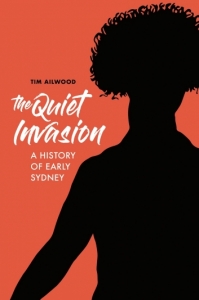 |
Tim Ailwood The Quiet Invasion: A History of Early Sydney Australian Scholarly Publishing, 2018‘The Quiet Invasion is the true history of Sydney’s first four years. A story of first contact, disease and famine, misunderstandings and bloody mindedness, tragedy and resilience. This history explodes the myths about the first years of the convict settlement on the shores of Sydney Cove and should change the way you feel about Australian history.Week by week, month by month, a detailed story of invader and invaded unfolds as the town of Sydney is literally hacked out of the place once called Warrane. The book follows the men and women who eked out their lives on the shores of Sydney Cove with a host of historical figures: Arthur Phillip, Bennelong, Watkin Tench, Barangaroo, William Dawes, Patyegarang, David Collins, Colbee, John Macarthur, Daringa, Henry Lidgbird Ball, Pemulwuy, William Bradley – to name just a few.’ Australian Scholarly Publishing |
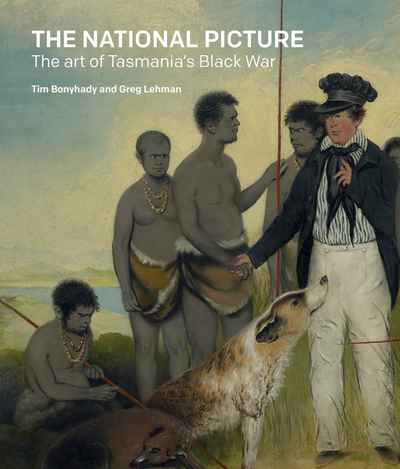 |
Tim Bonyhady and Greg Lehman, The National Picture: The art of Tasmania’s Black War National Gallery of Australia, 2018’Benjamin Duterrau and his National picture project are at the core of this publication because he was the colonial artist most interested in Tasmania’s Aboriginal people, and the only artist who chose to depict, on a substantial scale, their conciliation or pacification by George Augustus Robinson’, writes Tim Bonyhady and Greg Lehman in their introduction to The National Picture: The Art of Tasmania’s Black War.The fresh research presented by Bonyhady and Lehman in this insightful new book from the National Gallery of Australia will no doubt tantalise art lovers and historians alike. It will also appeal to anyone interested in Australia’s colonial past and in the ongoing interrogation of the historical record by Aboriginal artists and activists. Bonyhady and Lehman’s introduction continues: ‘For Tasmanian Aboriginal people today, Duterrau’s paintings provide a tantalising and rare visual record of the unique culture practice of their ancestors. Robinson’s journals offer written descriptions of activities, such as spear-making and throwing, kangaroo hunting and ceremonial dance, accompanied by only a scattering of small, often crude sketches, which are vitally important firsthand observations’.This publication serves to conjure up and interrogate Tasmania’s colonial past. Colonial representations of Tasmanian Aboriginal people are among the most remarkable and contentious expressions of Australian colonial art. The National Picture sheds new light on the under-examined figures in this difficult narrative: colonial artist Benjamin Duterrau, the controversial George Augustus Robinson and the Tasmanian Aboriginal people upon whose land the British settled. National Gallery of Australia |
 |
Stephen Gapps The Sydney Wars: Conflict in the early colony 1788–1817 NewSouth Publishing, 2018Sydney-based historian Stephen Gapps tells the story of early military engagements between British colonists and First Peoples of the region around the first colony in New South Wales. ‘… This is the first detailed account of the warfare that occurred across the Sydney region from the arrival of a British expedition in 1788 to the last recorded conflict in the area in 1817.’ This book reveals ‘how the British and Aboriginal forces developed military tactics and how the violence played out.’ Colonists, who often lived in fear, and convicts had a paramilitary role, while the British militia also were also deployed against First Nations who had lived in the Sydney region for m millennia. As their land and resources were plundered, Aboriginal people fought back. Their fight for survival was not only against British weapons but against deadly introduced diseases and the poverty of dispossession. |
 |
Jane Lydon and Lyndall Ryan eds This was the latest book on the Myall Creek Massacre in the lead-up to the 180th Anniversary Commemoration Ceremony held in June 2018. ‘The 1838 Myall Creek Massacre is remembered for the brutality of the crime committed by white settlers against innocent Aboriginal men, women and children, but also because eleven of the twelve assassins were arrested and brought to trial. Amid tremendous controversy, seven were hanged. Myall Creek was not the last time the colonial administration sought to apply the law equally to Aboriginal people and settlers, but it was the last time perpetrators of a massacre were convicted and hanged. Marking its 180th anniversary, this book explores the significance of one of the most horrifying events of Australian colonialism. Thoughtful and fearless, it challenges us to look at our history without flinching as an act of remembrance and reconciliation.’ NewSouth Books |
2017
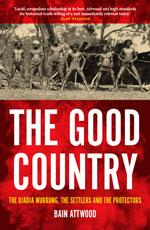 |
Bain Attwood ‘Beyond the generalisations of national and colonial history, what can we know about how Aboriginal nations interacted with the British settlers who invaded their country, the men appointed by the imperial and colonial governments to protect them, and each other? In The Good Country Bain Attwood makes a major contribution to our knowledge of this period by providing a superbly researched, finely grained local history of the Djadja Wurrung people of Central Victoria. The story is a shocking one, of destruction, decimation and dispossession, but, equally powerfully, it is not one of unceasing conflict. With reference to an unusually rich historical record, concepts such as the frontier and resistance emerge as inadequate in this context. Attwood recovers a good deal of the modus vivendi that the Djadja Wurrung reached with sympathetic protectors, pastoralists and gold diggers, showing how they both adopted and adapted to these intruders to remain in their own country, at least for a time. Finally, drawing past and present together, Attwood relates the remarkable story of the revival of the Djadja Wurrung in recent times as they have sought to become their own historians.’ |
 |
Nick Brodie The Vandemonian War: The secret history of Britain’s Tasmanian invasion Hardie Grant Books, 2017’Britain formally colonised Van Diemen’s Land in the early years of the nineteenth century. Small convict stations grew into towns. Pastoralists moved in to the aboriginal hunting grounds. There was conflict, there was violence. But, governments and gentlemen succeeded in burying the real story of the Vandemonian War for nearly two centuries.The Vandemonian War had many sides and shades, but it was fundamentally a war between the British colony of Van Diemen’s Land (Tasmania) and the Aboriginal people who lived in political and social contradiction to that colony. The Vandemonian War tells the largely untold story of how the British truly occupied Van Diemen’s Land deploying regimental soldiers and special forces, armed convicts and mercenaries.In the 1820s and 1830s the British deliberately pushed the Aboriginals out, driving them to the edge of existence. Far from localised fights between farmers and hunters of popular memory, this was a war of sweeping campaigns and brutal tactics, waged by military and paramilitary forces subject to a Lieutenant Governor who was also Colonel Commanding. The British won the Vandemonian War and then discretely and purposefully concealed it.Historians failed to see through the myths and lies–until now. It is no exaggeration to say that the tribes of Van Diemen’s Land were extirpated from the island. Whole societies were deliberately obliterated. This is ground breaking story, discovered in neglected handwriting nearly two centuries old, that redraws what we know about our history. The Vandemonian War is a dark stain on a former empire.’ Hardie Grant Publishing |
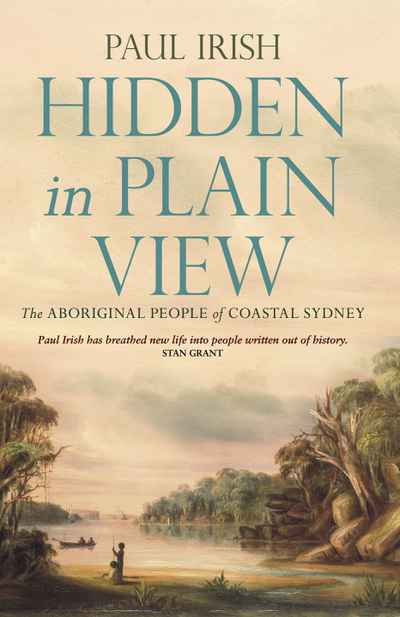 |
Paul Irish Hidden in Plain View: The Aboriginal People of Coastal Sydney NewSouth Publishing, 2017Despite the invasion and dispossession of their lands, deaths from killings, massacres, and imported illnesses to which they had no immunity, First Peoples did not lose their culture or die out within decades of the arrival of the First Fleet from England in 1788. ‘They did not vanish, as popular history has had us believe’. The surviving First Peoples of the Sydney area lived on Country, keeping their kinship system alive while continuing their culture and traditions. Although mentioned widely in early records of the Sydney colony, little information about Sydney’s Aboriginal people appeared between the early 1800s and the 20th century. Historian and archaeologist, Paul Irish, often working with descendants of the original Aboriginal people of the Sydney area and beyond, has brought their story in this period to life. Essential reading for anyone interested in the truth of Australian history as it applies to the colony of New South Wales. |
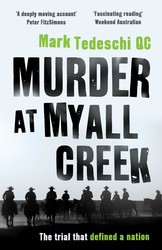 |
Mark Tedechi ‘One of the most shocking murder trials in Australia’s legal history, and the tribulations of the man who conducted it. In 1838, eleven convicts and former convicts were put on trial for the brutal murder of 28 Aboriginal men, women and children at Myall Creek in New South Wales. The trial created an enormous amount of controversy because it was almost unknown for Europeans to be charged with the murder of Aborigines. It would become the most serious trial of mass murder in Australia’s history. The trial’s prosecutor was the Attorney General of New South Wales, John Hubert Plunkett. It proved to be Plunkett’s greatest test, as it pitted his forensic brilliance and his belief in equality before the law against the combined forces of the free settlers, the squatters, the military, the emancipists, the newspapers, and even the convict population. From the bestselling author of Kidnapped and Eugenia, Murder at Myall Creekfollows the journey of the man who who arguably achieved more for modern-day civil rights in Australia than anyone else before or since. Praise for Murder at Myall Creek The Myall Creek massacre is a stain on our nation’s soul, with the only positive note being that the law brought the evil perpetrators to justice in a key trial that was a foundation stone for the integrity of our legal system. This wonderful book brings that trial, and the marvellous prosecutor, John Hubert Plunkett, back to life. A much needed and appreciated historical insight into the profession of a man who gained respect through the colonial era of Australia and his fight for justice through the law for my people, the Kamilaroi. Aunty Noeline Briggs-Smith OAM, Aboriginal researcher’ |
2016
____________________________________________________________________________________________________
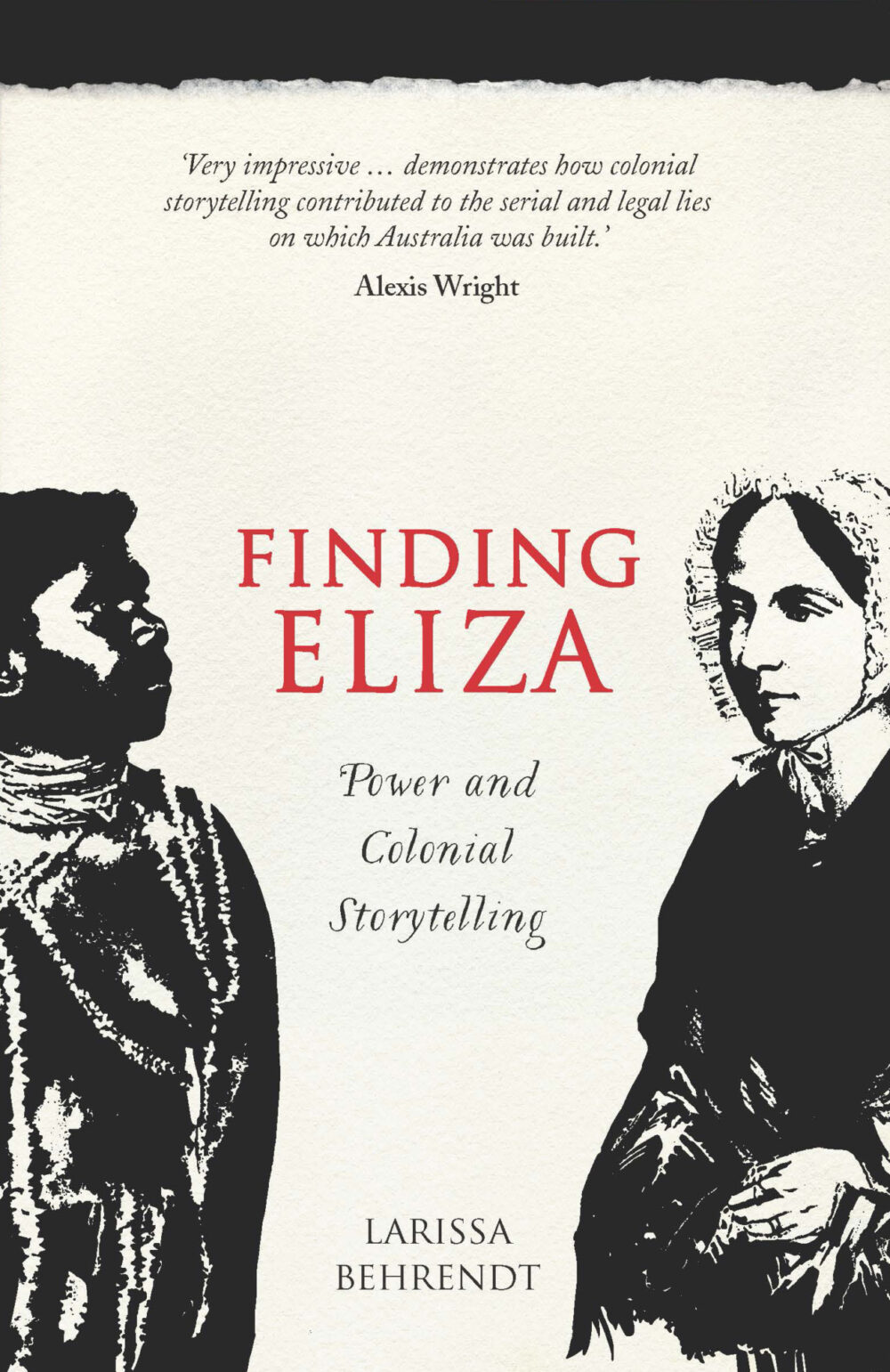 |
Larissa Behrendt, Finding Eliza: Power and Colonial Storytelling, University of Queensland Press, 2016
From Booktopia: A vital Indigenous perspective on colonial storytelling. ‘Larissa Behrendt takes us on the epic colonial narrative of Eliza Fraser, who has been a yoke around the necks of the Butchulla (Badtjala) people and in particular our women . . . Finding Eliza covers much ground and is compelling reading.’ Fiona Foley |
 |
Erika Charola and Felicity Meakins eds Yijarni: True Stories from Gurindji Country Aboriginal Studies Press, 2016’On 23 August 1966, approximately 200 Gurindji stockmen and their families walked off Wave Hill Station in the Northern Territory, protesting against poor working conditions and the taking of their land by pastoralists. Led by Vincent Lingiari, this land-mark action in 1966 precipitated the equal wages case in the pastoral industry and the establishment of the Aboriginal Land Rights (Northern Territory) Act 1976.While it is well known that the Walk Off was driven by the poor treatment of Aboriginal workers, what is less well known is the previous decades of massacres, killings, stolen children and other abuses by early colonists as well as (some) classic pre-contact stories. Told in both English and Gurindji, these compelling and detailed oral accounts of the events that the Gurindji elders either witnessed or heard from their parents and grandparents, will ignite the interest of audiences nationally and internationally and challenge revisionist historians who question the extent of frontier battles and the legitimacy of the Stolen Generations.’ Aboriginal Studies Press |
 |
Cal Flyn Thicker Than Water: A Memoir of Family, Secrets, Guilt and History Fourth Estate, 2016In Thicker Than Water, Scottish journalist, Cal Flyn, has written about a terrible family secret that she discovered. Her great-great-great uncle, Angus McMillan, revered as an explorer and pioneer in colonial Australia, turned out to be ‘the Butcher of Gippsland’ who led ‘the Highland Brigade’ against the Kurnai/Gunai people.The book combines family memoir, history and travel to reveal what the publishers, Fourth Estate, describe as ‘a fascinating journey into our Australian heritage … [and] a ‘compelling and devastatingly clear-eyed examination of the burden of intergenerational grief and inherited guilt that we all carry with us.’ |
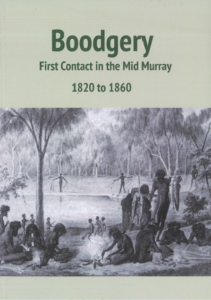 |
John Lay Boodgery: First Contact in the Mid Murray 1820 to 1860 Not So Shabby Books, 2016 ‘The annihilation of them (the Aborigines) within one generation … will in time to come remain one of the blackest acts upon the Australian escutcheon.’ – A correspondent to The Argus, 26 November 1857 For a long period in the Australian story, the extent of the violence at the Frontier, and the impact of the European occupation on the Aborigines was sanitised, ignored or lost. For several generations there was a deafening silence. Some recognised it, a few openly complained, but for most there was a deafening silence [sic]. Some recognised it, a few openly complained, but for most there was silence. To be able to move forward we need to know what happened and what the consequences of this were. The Mid Murray area of Victoria has always had a relatively large population of Aborigines, however what happened here in the early years of European settlement is largely unknown. This book is a small part in the recovery of this knowledge. Here, some gaps are filled in for a small area of the continent, which can also be extrapolated to the wider picture.’: |
 |
Jonathan Lim The Battle of Parramatta–21 to 22 March 1797 Australian Scholarly Publishing, 2016’The enigmatic figure of Pemulwuy, the Darug leader who dared to rebel against white settlers, haunts the story of the early colonisation of New South Wales–in particular, the remarkable incident known as the Battle of Parramatta. Aboriginal warriors advanced against the settlement of Parramatta, challenging the garrison of redcoats to battle. Pemulwuy was wounded seven times, but he escaped and became more powerful and rebellious than ever.Making use of little-known sources and knowledge of the geography and settlement of the area, this book deals in depth with the battle and the dramatic events leading up to it, covering: • the remarkable story of convict settlement in the frontier world of the Northern Boundary, today the Sydney suburbs of Carlingford, Oatlands and North Parramatta • the desperate guerrilla campaign waged by Pemulwuy • the double-murder of settlers and long pursuit through the bush which led up to the battle • the exact date and location of the battle, previously unknown, together with the incidents of the battle and probable numbers of combatants involved and casualties • the outcome, Pemulwuy’s strange ‘resurrection’, and his vengeful follow-up attacks …This book contains in full the text of all original sources relating to this battle.’ Australian Scholarly Publishing |
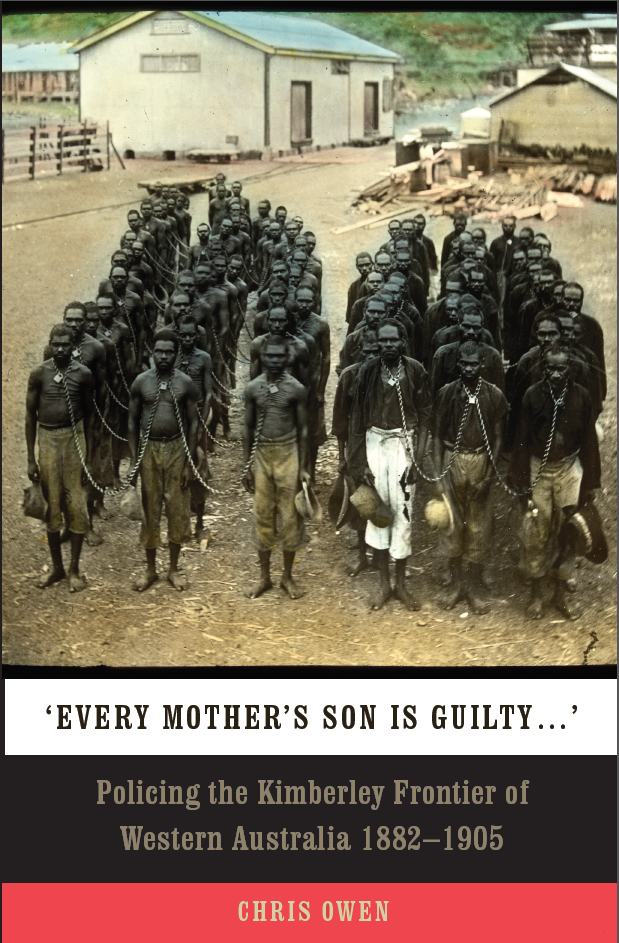 |
Chris Owen ‘In Every Mother’s Son is Guilty, Chris Owen provides a compelling account of policing in the Kimberley district from 1882, when police were established in the district, until 1905 when Dr. Walter Roth’s controversial Royal Commission into the treatment of Aboriginal people was released. Owen’s achievement is to take elements of the pre-existing historiography and test them against a rigorous archival investigation. In doing so a fuller understanding of the complex social, economic and political changes occurring in Western Australia during the period are exposed. The policing of Aboriginal people changed from one of protection under law to one of punishment and control. The subsequent violence of colonial settlement and the associated policing and criminal justice system that developed, often of questionable legality, was what Royal Commissioner Roth termed a ‘brutal and outrageous state of affairs’. Every Mother’s Son is Guilty is a significant contribution to Australian and colonial criminal justice history.’ |
 |
WF Refshauge ‘As one of the foundation events in Tasmanian history, what happened at Risdon Cove on 3 May 1804 has always had a place in narrative histories. A large party of Aborigines found themselves within the new English settlement, the first site for Hobart. They appeared to be astonished; the English certainly were. The officer in charge of the settlement on that day was Lieutenant William Moore, and his troops fired on the Aborigines, killing a number that was estimated variously from three to fifty. W. F. Refshauge believes that the dead have not been well cared for by the living. Stories about the killings often show a poor understanding of what happened, and have added fanciful touches to the limited information available. Adopting an analytical rather than a narrative approach, his aim is to clear away as much unreliable matter as possible, yielding a more informed perspective on the day’s most unfortunate happenings.’ |
2015
 |
Fiona Foley, Louise Martin-Chew, Fiona Nicoll eds, Courting Blakness: Recalibrating Knowledge in the Sandstone University, University of Queensland Press, 2015
‘In a bold and unprecedented project, acclaimed international artist Fiona Foley curated a cutting-edge installation in the University of Queensland’s sandstone Great Court. Universities have traditionally been elite institutions, overlooking and undervaluing the knowledge contributions of Indigenous thinkers, activists and artists. This history is etched into the walls of the Great Court, with anachronistic concepts of humanity and racial difference revealed in many of the friezes and sculptural reliefs. Fiona Foley and her team of eight Aboriginal artists aimed to challenge these concepts. The ‘Courting Blakness’ exhibition reclaimed this historically white space, creating a visual dialogue between contemporary Aboriginal art and colonial-inspired architecture. It also sparked important conversations about issues that matter to both Indigenous and non-Indigenous Australians. Featuring striking images as well as essays by artists, curators and academics, Courting Blakness is a stylish and comprehensive tribute to this innovative project.’ |
 |
Libby Connors Warrior: A Legendary Leader’s Dramatic Life and Violent Death on the Colonial Frontier Allen & Unwin, 2015 |
‘The fascinating story of one of the great Aboriginal resistance fighters of the colonial frontier and a compelling portrait of life in early Brisbane.
‘Connors lays down the hard truth. Not all our warriors were Anzacs. Not all our wars were just.’ – John Birmingham, author and columnist
In the 1840s, white settlement in the north was under attack. European settlers were in awe of Aboriginal physical fitness and fighting prowess, and a series of deadly raids on homesteads made even the townspeople of Brisbane anxious.
Young warrior Dundalli was renowned for his size and strength, and his elders gave him the task of leading the resistance against the Europeans’ ever increasing incursions on their traditional lands. Their response was embedded in Aboriginal law and Dundalli became one of their greatest lawmen. With his band of warriors, he had the settlers in thrall for twelve years, evading capture again and again, until he was finally arrested and publicly executed.
Warrior is the extraordinary story of one of Australia’s little-known heroes, one of many Aboriginal men to die protecting their country. It is also a fresh and compelling portrait of life in the early days of white settlement of Brisbane and south east Queensland.
‘An enduring record of one of our greatest heroes.’ – Sam Watson, activist and writer
‘Deeply considered and powerfully told, this book recovers the entangled history of Aboriginal people and settlers in colonial Queensland, a history which is also Australia’s story writ large.’ – Associate Professor Grace Karskens, University of NSW’
Allen & Unwin
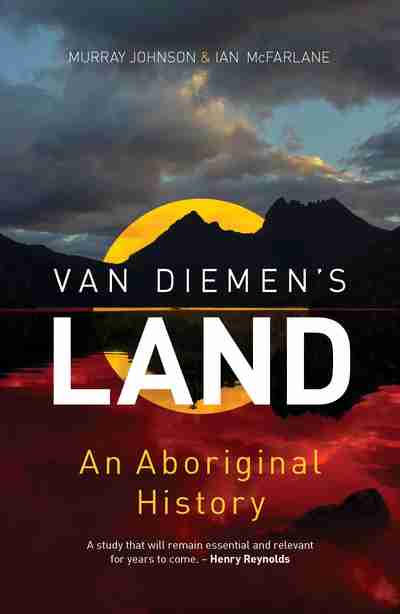 |
Murray Johnson and Ian McFarlane ‘The definitive history of the Aborigines in Tasmania, providing a detailed analysis of all the key issues that have marked the Aboriginal presence on the island for more than thirty-five millennia. The history of the Aborigines in Van Diemen’s Land is long. The first Tasmanians lived in isolation and against insurmountable odds for as many as 300 generations after the flooding of Bass Strait. This broad-ranging book is a comprehensive and critical account of that epic survival up to the present day. Starting from antiquity, the book examines the devastating arrival of Europeans and subsequent colonisation , warfare and exile. It emphasises regionalism and separateness–a consistent feature of Aboriginal life since time immemorial that has led to the distinct identities we see today. Carefully researched using extensive archaeological and documentary evidence, this important book fills a long-time gap in Tasmanian history.’ |
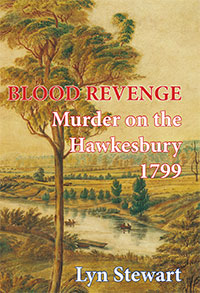 |
Lyn Stewart ‘Blood Revenge examines the first time that white men were held to account in a criminal court of New South Wales for killing Australian Aborigines. It happened in 1799, just eleven years after the New South Wales colony was established. This book answers the disturbing question: Why were five men found guilty of killing two Aborigines–yet they were never punished? The story lays bare the nature of black-white relations at the colony’s Hawkesbury River frontier settlement. Governor John Hunter tried to carry out his orders and stop the wanton killing of Aborigines. Inevitably, there was a divide between policy and practice, and tensions and disputes between the Governor and members of the New South Wales Corps and the fledgling judiciary. In Blood Revenge the politics of this murder case read like a missing chapter of Doc Evatt’s Rum Rebellion. Historians writing about black-white relations say we will never reach true reconciliation until we are prepared to face the truth of our history. [My emphasis] Author Lyn Stewart’s own ancestor was amongst those who murdered two Aborigines at the Hawkesbury River settlement over two hundred years ago. “My grandfather thought this was something we should not talk about,” she writes. “By delving into this part of my family history I have learned not only why the murders happened but also about the volatile and uncertain relationships between settlers and Aborigines as the colony’s land grants steadily displaced the local people from their traditional lands. It is a history we must understand.”‘ |
2014
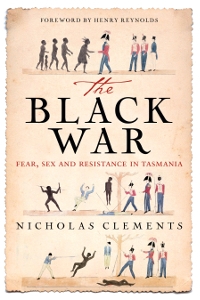 |
Nicholas Clements The Black War: Fear, Sex and Resistance in Tasmania University of Queensland Press, 2014’At it’s core, The Black War is a story about two peoples who just wanted to be free of each other …sooner or later Europeans and Aborigines were bound to clash, but it was Tasmania’s unique circumstances that turned this encounter into a “war of extermination”.’Between 1825 and 1831 close to 200 Britons and 1000 Aborigines died violently in Tasmania’s Black War. It was by far the most intense frontier conflict in Australia’s history, yet many Australians know little about it. The Black War takes a unique approach to this historic event, looking chiefly at the experiences and attitudes of those who took part in the conflict. By contrasting the perspectives of colonists and Aborigines, Nicholas Clements takes a deeply human look at the events that led to the shocking violence and tragedy of the war, detailing raw personal accounts that shed light on the tribes, families and individuals involved as they struggled to survive in their turbulent world.The Black War presents a compelling and challenging view of our early contact history, the legacy of which reverberates strongly to the present day. University of Queensland Press |
2013
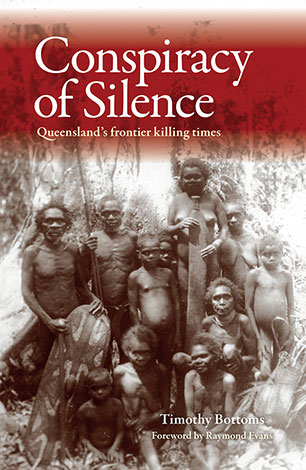 |
Timothy Bottoms Conspiracy of Silence: Queensland’s frontier killing times Allen & Unwin, 2013As Europeans moved into new lands in Queensland in the 19th century, violent encounters with local Aboriginals mostly followed. Drawing on extensive original research, Timothy Bottoms tells the story of the most violent frontier in Australian colonial history. ‘This is an important, well researched book: challenging, compelling and controversial. It is a must read for anyone interested in Australian history.’ – Henry Reynolds The Queensland frontier was more violent than any other Australian colony. From the first penal settlement at Moreton Bay in 1824, as white pastoralists moved into new parts of country, violence invariably followed. Many tens of thousands of Aboriginals were killed on the Queensland frontier. Europeans were killed too, but in much smaller numbers. The cover-up began from the start: the authorities in Sydney and Brisbane didn’t want to know, the Native Police did their deadly work without hindrance, and the pastoralists had every reason to keep it to themselves. Even today, what we know about the killing times is swept aside again and again in favour of the pioneer myth. Conspiracy of Silence is the first systematic account of frontier violence in Queensland. Following in the tracks of the pastoralists as they moved into new lands across the state in the nineteenth century, Timothy Bottoms identifies massacres, poisonings and other incidents, including many that no-one has documented in print before. He explores the colonial mindset and explains how the brutal dispossession of Aboriginal landowners continued over decades. ‘… a road-map back into what seems, from a modern perspective, to be a barely conceivable past.’ – From the foreword by Raymond Evans Timothy Bottoms has also produced an accompanying video, Conspiracy of Silence, which you can view at: https://www.youtube.com/watch?time_continue=7&v=oQI5ySAAhYg |
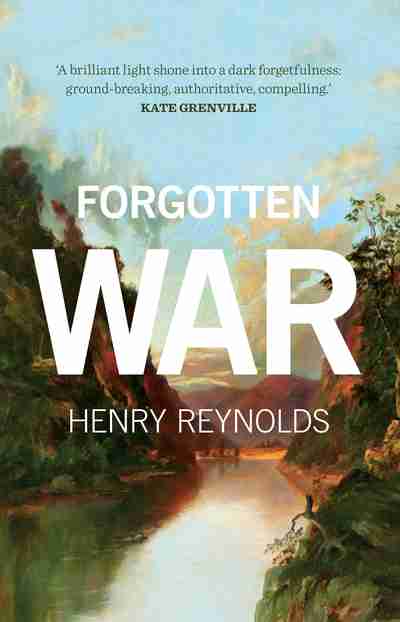 |
Henry Reynolds ‘Australia is dotted with memorials to soldiers who fought in wars overseas. Why are there no official memorials or commemorations of the wars that were fought on Australian soil between Aborigines and white colonists? Why is it more controversial to talk about the frontier wars now than it was one hundred years ago? Forgotten War continues the story started by Henry Reynolds’ seminal book The Other Side of the Frontier, which argued that the settlement of Australia had a high level of violence and conflict that we chose to ignore. That book prompted a flowering of research and fieldwork that Reynolds draws on here to give a thorough account of the frontier wars between white colonists and Aborigines, how many people died and whether the colonists themselves saw the violence as a form of welfare. This powerful book makes it clear that there can be no reconciliation without acknowledging the wars fought on our own soil.’ |
2012
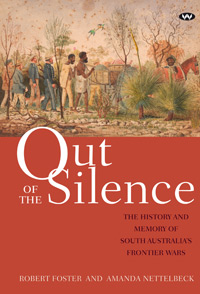 |
Robert Foster and Amanda Nettelbeck Out of the Silence: The History and Memory of South Australia’s Frontier Wars Wakefield Press, 2012Out of the Silence explores the nature and extent of violence on South Australia’s frontiers in light of the foundational promise to provide Aboriginal people with the protection of the law, and the resonances of that history in social memory. What do we find when we compare the history of the frontier with the patterns of how it is remembered and forgotten? And what might this reveal about our understanding of the nation’s history and its legacies in the present?’When South Australia was founded in 1836, the British government was pursuing a new approach to the treatment of Aboriginal people, hoping to avoid the violence that marked earlier Australian settlement. The colony’s founding Proclamation declared that as British subjects, Aboriginal people would be as much ‘under the safeguard of the law as the Colonists themselves, and equally entitled to the privileges of British subjects’. But could colonial governments provide the protection that was promised?Praise for Out of the Silence: ‘Out of the Silence is a comprehensive examination of the nature and extent of violence between Aboriginal people and colonists on the South Australian and Northern Territory frontiers.’ – Nic Klaassen, Flinders Ranges Research‘Injustice against Aboriginal peoples in the founding of the nation casts a shadow over our future. Until we address our moral obligation to make reparation as fully as we can, we will never escape the stain on our memory. Out of the Silence is well argued and it provides insight into the way forward.’ – Paul W. Newbury, Bonzer (Sept 2012) Wakefield Press |
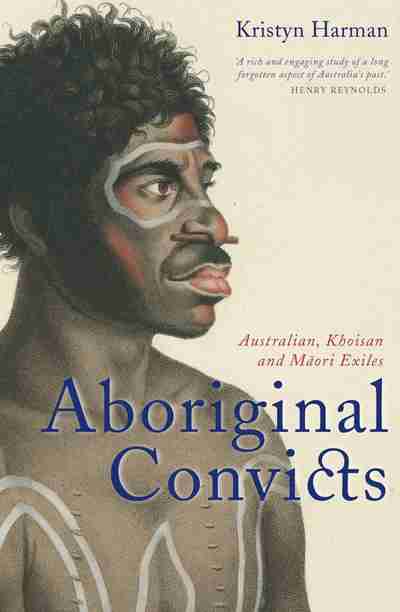 |
Kristyn Harman Aboriginal Convicts: Australian, Khoisan and Maori Exiles UNSW Press, 2012’Bulldog and Musquito, Aboriginal warriors from the Hawkesbury, were captured and sent to Norfolk Island following frontier skirmishes in New South Wales. Eventually, Bulldog seems to have made it home. Musquito was transported to Van Diemen’s Land, where he laboured as a convict servant. He never returned. Hohepa Te Umuroa was arrested near Wellington in 1846, with a group of Maori warriors. Five of the men were transported to Van Diemen’s Land where Te Umuroa died in custody. More than 140 years later, his remains were carried home to New Zealand. Booy Piet, a twenty-six year-old Khoisan soldier from the Cape Colony, was transported to Van Diemen’s Land for desertion in 1842. After three years of convict labour, he died in Hobart General Hospital. These men are among 130 aboriginal convicts who were transported to and within the Australian penal colonies. They lived, laboured, were punished, and died alongside other convicts, but until this groundbreaking book, their stories had largely been forgotten.’ Joint winner of the Northern Territory Chief Minister’s History Book Award 2013 University of New South Wales Press |
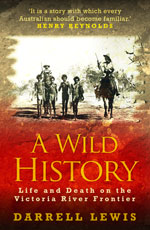 |
Darrell Lewis A Wild History: Life and Death on the Victoria River Frontier Monash University Publishing, 2012’In 1883 pastoralists began to drive great herds of cattle into Victoria River District of Australia’s Northern Territory. They entered a vast tropical land of big rivers, wide plains, and rugged ranges. It was a cattleman’s paradise, but also a paradise for the Aboriginal people who had lived there for thousands of years. Each side came to see the other as the serpent in the garden–a serpent that had to be banished–and a twenty year war ensued. The cattlemen won, but it was a pyrrhic victory. The coming of the cattle began the destruction of the paradise for both.The frontiersmen who came to the district included cattle and horse thieves, outlaws, capitalists, dreamers, drunks, madmen and others. Together they established massive stations of up to 12,000 square miles on the traditional lands of the Aborigines. This book looks at them all, from the explorers of the 1830s and 1850s to the founders of the big stations in the 1880s and 1890s, and finally at the ‘golden era’ of the cattle duffers in the early 1900s.Drawing on painstaking research into obscure though rich documentary sources, Aboriginal oral traditions, and first-hand investigations in the region over thirty-five years, Darrell Lewis pieces together the complex interactions between the environment, the powerful and warlike Aboriginal tribes and the settlers and their cattle, which produced what truly became A Wild History.’Joint Winner of the Northern Territory Chief Minister’s History Book Award 2013 Monash University Publishing |
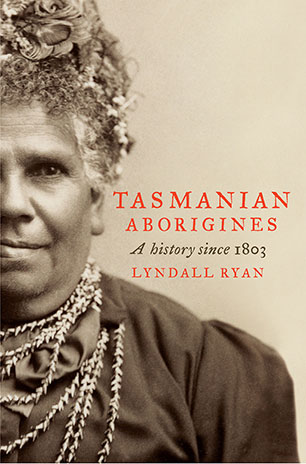 |
Lyndall Ryan Tasmanian Aborigines: A history since 1803 Allen & Unwin 2012’Tasmanian Aborigines were driven off their land so white settlers could produce fine wool for English textile mills. By the time Truganini died in 1876, they were considered to be extinct. Yet, like so many other claims about them, this was wrong.Far from disappearing, the Tasmanian Aborigines actively resisted settler colonialism from the outset and have consistently campaigned for their rights and recognition as a distinct people through to the present.Lyndall Ryan tells the story of the Aboriginal people of Tasmania, from before the arrival of the first whites to current political agendas. Tasmania has become the cradle of race relations in Australia, and their struggle for a place in their own country offers insights into the experiences of Aboriginal people nation-wide.’ Allen & Unwin |
2011
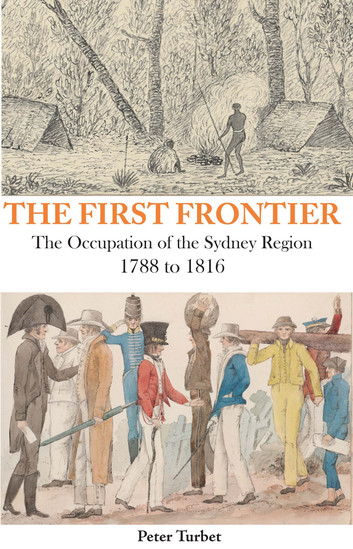 |
Peter Turbet The First Frontier: The Occupation of the Sydney Region 1788–1816 Rosenberg, 2011’The arrival of the First Fleet heralded monumental and often catastrophic changes to the lives of the indigenous peoples living between the Blue Mountains and the sea. As British settlement spread out from Sydney Cove the next 28 years saw frequent flare-ups of violence as disputes over precious resources erupted and the Aborigines’ connection with the land was challenged. Raids on isolated farms would often be followed by a totally disproportionate reprisal from the military and settlers, but colonists and Aborigines often knew each other well and trust and friendship remained constant throughout periods of bloodshed. This book delves into the background of the people who were involved in some events, tragic and otherwise that occurred up until the end of hostilities in the Sydney Region in 1816. It examines the relationships between the two societies in those early years of the colony.’ Kobo.com |
2010
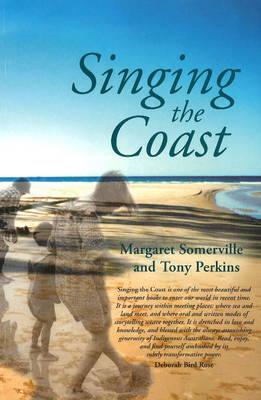 |
Margaret Somerville and Tony Perkins Singing the Coast: Place and Identity in Australia Aboriginal Studies Press, 2010, reprinted 2011′Singing the Coast offers readers a rare opportunity to visit the heart of Gumbaynggirr culture and trace the shaping of place and identity in coastal Australia. The story began under the coral trees at the Old Camp where Tony Perkins first sat with his grandfather and listened to his stories. His grandfather was an initiated man who brought the spirit creatures along to teach the knowledge that was once passed on in initiation. By recording their stories Gumbaynggirr people invite us to share their intimate connection with their land. The stories are brought into a contemporary present at Muurrbay through deep mapping of the songlines that cross Gumbaynggirr country to reveal how people, place and identity are connected. Tony Perkins and Margaret Somerville take up the challenge of speaking from the place between Aboriginal and settler stories to share the experience of this rich collaboration.’ Aboriginal Studies PressChapter 2 of Singing the Coast, Crying-songs to remember, deals specifically with the Red Rock massacre story from the 1880s from an Aboriginal perspective. You can read more about the Gumbaynggirr people, their culture, history and the Red Rock Massacre, in a fact sheet on the Gumbaynggirr Nation: https://docslib.org/doc/4845338/fact-sheet-1-gumbaynggirr-nation-then-in-the-1930s-they-were-forced-from-their-camp-on-if-you-draw-a-line-red-rock-river-southward-to-threepenny-gate-near-corindi |
2009
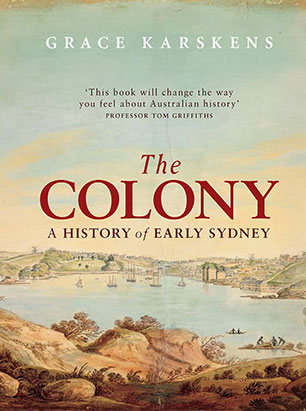 |
Grace Karskens The Colony: A History of Early Sydney Allen & Unwin, 2009, 2010’A landmark account of the birthplace of modern Australia.’ A good book to compare with some later accounts (listed above) of what happened in early Sydney between colonists and First Peoples. |
2008
 |
Jonathan Richards The Secret War: A True History of Queensland’s Native Police University of Queensland Press, 2008’For many Aboriginal people, white colonisation arrived with the armed men of the Native Police: a brutal force that operated on the 19th-century frontier, killing large numbers of Indigenous people.Native Police detachments – mounted Aboriginal troopers led by white officers – would surround Aboriginal camps and fire into them at dawn, killing men, women and children.The bodies were often burned to destroy the evidence.Historian Jonathan Richards has spent ten years researching this controversial subject, picking his way through the secrecy, misinformation and supposed ‘lost files’.In this first full-length comprehensive study of the Native Police in Queensland, Richards argues that they were a key part of a ‘divide and rule’ colonising tactic, used with equal success elsewhere in the British Empire; that the force’s actions were given the implicit approval of government and public servants; and that their killings were covered-up. The Secret War is an authoritative and groundbreaking contribution to our country’s white settlement history.’ University of Queensland Press |
2007
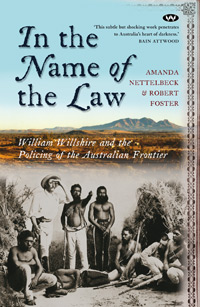 |
Amanda Nettelbeck and Robert Foster In the Name of the Law: William Willshire and the Policing of the Australian Frontier Wakefield Press, 2007’Mounted Constable William Willshire commanded a corps of Native Police in Central Australia during the 1880s. Notorious for the violence of his patrols, he was eventually tried in 1891 for the murder of two Aboriginal men, and was posted to an even more remote frontier in the Top End. During his time in the Territory, Willshire wrote of his experiences in several extraordinary memoirs. Part murder mystery and part courtroom drama, his story illuminates unfolding issues of race and nationalism in colonial Australia on the eve of Federation.Praise for In the Name of the Law: ‘This subtle but shocking work penetrates to Australia’s heart of darkness …’ – Bain Attwood’ Wakefield Press |
 |
Bruce Pascoe Convincing Ground: Learning to Fall in Love with Your Country Aboriginal Studies Press, 2007, reprinted 2012′Convincing Ground is a wide-ranging, personal and powerful work which resonates with historical and contemporary Australian debates about identity, dispossession, memory and community.Pascoe ranges across the national contemporary political stage, critiquing the great Australian silence when it comes to dealing respectfully with the construction of the nation’s Indigenous past.Forget the history wars. Pascoe has written a book for all Australians. He believes early colonial behaviour on Gunditchmurra lands, near Portland, Victoria, shaped us then and shapes us still — physically and intellectually. Through a close, critical examination of the major historical works and witness accounts, Pascoe draws uncanny parallels between the techniques, language and results of the invasion to contemporary times.For Pascoe, the Australian character was not forged at Gallipoli, Eureka and the back of Bourke, but in the more satanic furnace of Murdering Flat, Convincing Ground and Werribee. He knows we can’t reverse the past, but we can bring our soul in from the fog of delusion. He proposes a way forward, beyond shady intellectual argument and immature nationalism: strengths intact; weaknesses acknowledged and addressed.’ Aboriginal Studies Press |
2005
 |
Bain Attwood Telling the Truth About Aboriginal History Allen & Unwin, 2005’… Bain Attwood takes us to the heart of the conflict about the Aboriginal past in Australia. He tracks the growing popularity of history and weighs the consequences for the nature of historical knowledge and the authority of the historian. He asks why and how Aboriginal history has become central to Australian politics, culture and identity. He examines the work of historical ‘revisionists’ and tests their promise of historical truth. Finally, Attwood ponders how the traumatic history of frontier conflict might better be remembered – and mourned – and why telling the truth about history matters for the nation and for all of us.’ Allen & Unwin |
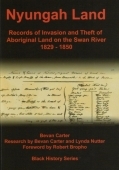 |
Bevan Carter Nyungah Land: Records of Invasion and Theft of Aboriginal Land on the Swan River 1829–1850 Black History Series, Swan Valley Nyungah Community, 2005’In an address to the Legislative Council in June 1837, Governor James Stirling referred on two occasions, to invading the Swan River region. On the first occasion he talks of the colonists desiring to avoid “on their invasion of this territory, every unnecessary injury to its earlier inhabitants.” In the second instance he refers to regulating “the future intercourse between the invaders and the invaded.”If it was good enough for Stirling to describe the arrival of the British at the Swan River as an invasion, then we felt comfortable using the expression in the sub-title of our book.No writer referred to the land being stolen by the British, but many euphemisms were used:
and today
Many of the early colonists discovered the land was owned by Aboriginal people and was forcibly being taken from them. Their reactions to this deepening realisation and the records of disruption to the lives of the original landowners fills the pages of this book. |
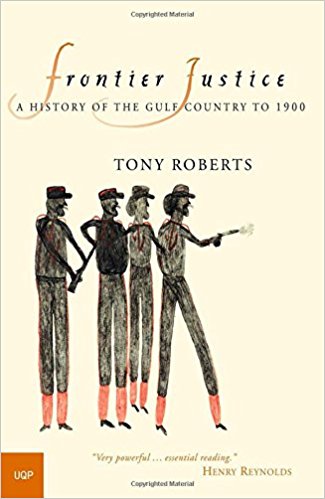 |
Tony Roberts Frontier Justice: A History of the Gulf Country to 1900 University of Queensland Press, 2005, reprinted 2008’A challenging and illuminating history, Frontier Justice brings a fresh perspective on the Northern Territory’s remarkable frontier era. For the newcomer, the Gulf Country–from the Queensland border to the overland telegraph line, and from the Barkly Tableland to the Roper River–was a harsh and in places impassable wilderness. To explorers like Leichhardt, it promised discovery, and to bold adventurers like the overlanders and pastoralists, a new start. For prospectors in their hundreds, it was a gateway to the riches of the Kimberley goldfields. To the 2,500 Aboriginal inhabitants, it was their physical and spiritual home. From the 1870s, with the opening of the Coast Track, cattlemen eager to lay claim to vast tracts of station land brought cattle in massive numbers and destruction to precious lagoons and fragile terrain. Black and white conflict escalated into unfettered violence and retaliation that would extend into the next century, displacing, and in some areas destroying, the original inhabitants.The vivid characters who people this meticulously researched and compelling history are indelibly etched from diaries and letters, archival records and eyewitness accounts. Included are maps with original place names, and previously unpublished photographs and illustrations.’ University of Queensland Press |
2004
 |
Henry Reynolds, Fate of a Free People: The classic account of the Tasmanian wars, Penguin, First published 1995. Revised and Updated 2004
“In this critically acclaimed and ground-breaking book, first published in 1995, Henry Reynolds presented a landmark reassessment of the n nineteenth century ‘black wars’ between Tasmanian Aborigines and white settlers. Now updated for a new audience, Fate of a Free People challenges long-accepted views of the Aborigines as a passive people ‘rescued’ by G.A. Robinson and reduced to the status of prisoners on Flinders Island. Reynolds’ research reveals that the Aborigines in fact bravely defended their homelands against the white invaders with skilful bush craft and sophisticated guerrilla tactics. Reynolds argues that their subsequent ‘exile’ to Flinders Island was not due to defeat but was, in fact, part of a negotiated treaty that the colonial government failed to honour. Highly readable and with far-reaching implications for all Australians, Fate of a Free People redresses the whitewash and dispels long-held myths about the nature and fate of Tasmania’s Indigenous people.” Penguin Books |
2002
 |
Patrick Collins, Goodbye Bussamarai; the Mandandanji Land War, Southern Queensland 1842–1952, University of Queensland Press, 2002. View the website about this book: https://www.goodbyebussamarai.com/ |
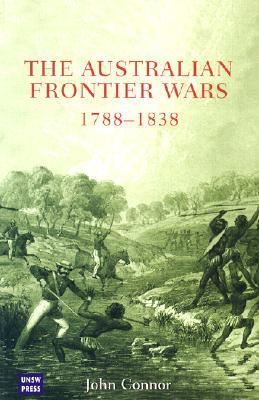 |
John Connor ‘From the Swan River to the Hawkesbury, and from the sticky Arnhem Land mangrove to the soft green hills of Tasmania, this book describes the major conflicts fought on the Australian frontier to 1838. Based on extensive research and using overseas frontier wars to add perspective to the Australian experience, The Australian Frontier Wars 1788-1838 will change the view of Australian history forever. Over the last thirty years, Australians have become increasingly aware that violence accompanied the colonisation of their continent. Historians have shown that the armed conflicts between Aborigines and British settlers and soldiers, though small in scale and sporadic in nature, can truly be described as ‘wars’. However a gap remains at the heart of our understanding of the Australian frontier: the actual warfare, and the weapons and tactics used to fight it, remain poorly understood. The Australian Frontier Wars is the first book-length military history of frontier conflict in Australia. Covering the first fifty years of British occupation in Australia, this book examines in detail how both sides fought on the frontier. It shows how Aborigines developed a new form of warfare that differed from their traditional methods. Already expert in raids and ambush, Aborigines now used these skills to attack the settlers’ crops, stock and farmhouses. Raiding parties took goods and foodstuffs when they were useful, and destroyed them when they were not. When the terrain assisted these tactics, Aborigines were able temporarily to stop settlers occupying their land. While the British Army arrived in Australia with experience of frontier warfare in other parts of the Empire, it initially found it difficult to operate on the frontier. Aboriginal tactics overcame British muskets, and Aboriginal warriors evaded settlers and soldiers. However, once the British began using horses, they were able to track and attack Aboriginal groups, and gained the advantage that would bring them victory.’ Note: In the more than 19 years since John Connor wrote this book, many more academic and independent researchers have published material about Australian colonial frontier conflict, as shown throughout this website, but this is a good book from which to begin an understanding of the military nature of the conflict, that was carried forward by colonial police forces and through the actions of pastoralists, miners and others, many of whom killed Aboriginal and Torres Strait Islander people with impugnity. |
2001
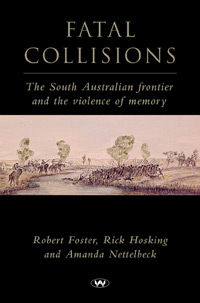 |
Robert Foster, Rick Hosking, Amanda Nettelbeck Fatal Collisions: The South Australian Frontier and the Violence of Memory Wakefield Press, 2001’In 1849, James Brown, a South Australian pastoralist, was charged with shooting dead nine Aboriginal people. Unable to find witnesses, the crown was forced to drop the case even though the magistrate was convinced of his guilt. Two generations later, a glowing biography of Brown’s life noted merely that he was involved in a charge of poisoning an Aboriginal man, but emerged from the trial with a clean slate. Why had the story changed so much: from shooting to poisoning, from nine victims to one, from evading trial to being found innocent? What forces were at play in reshaping the memory of this event?Fatal Collisions is about violence on the South Australian frontier and the ways in which it has been remembered in Anglo-Australian accounts of the past. The stories it tells take place in that fluid zone where history, memory and myth meet in popular consciousness.” Wakefield PressWinner of the 2002 John Tregenza prize for South Australian History Shortlisted for the 2002 NSW Premier’s Prize for LiteraturePraise for Fatal Collisions ‘A thought provoking book.’ – Paul W. Newbury, Bonzer‘This reassessment of the past has had a profound effect not only on the politics of the nation, but on the way we see ourselves as a nation … The timely reprint of this ‘great little book’ may go a long way towards reconciling the different points of view.’ – Nic Klaassen, Flinders Ranges Research |
1998
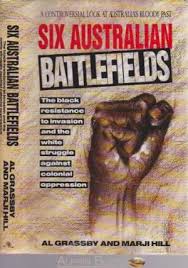 |
Al Grassby and Marji Hill Six Australian Battlefields: the black resistance to invasion and the white struggle against colonial oppression Angus & Robertson Publishers, 1998Below is a 1998 summary from Angus & Robertson describing the contents of Six Australian Battlefields:’Generations of Australians have been taught that the history of Australia began with Captain Cook, that the continent was settled peacefully and that no wars have ever been fought on Australian soil, no blood spilt. Yet the million or so Black Australians who were living here when Cook sighted the east coast have a history spanning tens of thousands of years. And more than 20,ooo of them died fighting a bloody war of resistance that lasted a hundred years–about the same number of Australian soldiers died in battle or as POWs in World War II.Six Australian Battlefields presents a new view of the history of Australia. Unlike many histories, it begins not 200 but some 50,000 years ago with a vivid outline of the extraordinary story of the Black nations who discovered and successfully colonised the continent. It deals in detail with their fight against the invasion of their lands that began in 1788, a heroic fight against vastly superior weapons of the army of occupation, the professional soldiers of successive British regiments and, later, the colonial auxiliaries.Four of the battles in this book were fought by Black Australians. The remaining two, at Vinegar Hill in New South Wales and Eureka in Victoria, were fought by others oppressed by the colonial administration. All were fought to achieve basic human rights.The Australian War Memorial contains the records of Australians killed fighting what were mostly other people’s wars in other countries. There is not one reference to those who fought in the Hundred Years War at home and died on Australian soil. In Six Australian Battlefields Al Grassby and Marji Hill speak for those who were defeated in battle and for those who believe that justice is still worth fighting for.’ Note: While the teaching of Australian history in schools and universities has improved a lot since 1998, and despite the growing body of excellent material on the subject, many Australians still know little, if anything, about the truth of Australia’s history since January 1788 when colonisation began with the arrival of the First Fleet. Although the Australian War Memorial (AWM) has accepted that the ‘frontier wars’ fought in colonial Australia, should be acknowledged, the AWM has put it on record that other institutions should present this part of Australian history. While the AWM does have a small collection of First Peoples’ artworks depicting the frontier wars, many Australians want the AWM to develop, in consultation with First Nations, a much larger permanent exhibition about Australia’s frontier conflicts, including wars. This does not mean that other Australian government institutions could not continue their often excellent presentations of Australia’s colonial frontier history. Australians who want the truth of our history to be told continue their truth-telling campaigns around the country despite moves in some jurisdictions to defund truth and justice commissions. |
 |
Bruce Elder Blood on the Wattle: Massacres and Maltreatments of Aboriginal Australians since 1788 New Holland Publishers, 1988. Reprinted 1992, 1994 and 1996. Revised edition 1998, reprinted 1999, 2000.‘Documenting some of the most significant, albeit painful, events in white Australia’s past, this work was first published to coincide with the Bicentenary in 1988. This revised and updated edition includes new information on three key events in Aboriginal-European relations which have come to light since publication of the first edition, and gives an overview of the Stolen Generation report.’ Goodreads |
1995
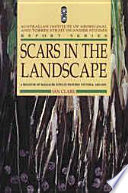 |
Ian D Clark Scars in the Landscape: a register of massacre sites in Victoria Australian Institute of Aboriginal and Torres Strait Islander Studies, 1995′Scars in the Landscape is a register of massacres and killings of Aboriginal people during 1803-1859. Deliberately challenging the ideology that the colonisation of Western Victoria was peaceful, the register reveal that violence was widespread. Through searching contemporary archival material, utilising Aboriginal oral history and local histories, and by studying place names in the region, Ian Clark presents a detailed, meticulously research study of massacres on one Australian region.’ Google Books |
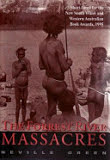 |
Neville Green The Forrest River Massacres Fremantle Arts Centre Press, 1995’In June 1926 fourteen people, led by two young police constables, rode onto the Marndoc Aboriginal reserve in Australia’s north-west in search of the murders of a white stockman. Several weeks later, dozens, perhaps hundreds, of tribal Aborigines were dead, their bodies dismembered and burnt in an attempt to conceal the evidence.But for the dogged efforts of the self-righteous and autocratic Reverend Ernest Gribble, one of twentieth-century Australia’s most horrific crimes might never have come to light. In the end, though, the conspiracy of silence prevailed, and none were punished.In the first published account of the Forrest River massacres, Neville Green shows that the infamous events of 1926 were no aberration, but the culmination of four decades of frontier violence, as white pastoralists fought to wrest control of the land away from its traditional owners.’ Fremantle Arts Centre Press |
 |
Howard Pedersen and Banjo Woorunmurra Jandamarra and the Bunuba Resistance Magabala Books, 1995 Reprinted 2000, 2007, 2011, 2018 (The cover shown is that for the 2018 publication)’The true story of the Aboriginal resistance fighter, Jandamarra, whose legend is etched into the Australian landscape. Set in the Kimberley outback during the late nineteenth century, the last stage of Australia’s invasion is played out in the lands of the Bunuba people. Leases are marked across Aboriginal country and, amidst the chaos and turmoil, extraordinary and sometimes contradictory relationships develop. A powerful collaboration between a non-Indigenous historian and the Indigenous custodians of the Jandamarra story.’Winner of the 1996 Western Australia Premier’s Book of the Year Award and Historical and Critical Studies category Magabala BooksTeachers Notes available at: https://cdn.shopify.com/s/files/1/0092/5043/9268/files/Jandamarra_and_the_Bunuba_Resistance.pdf?2729 |
1992
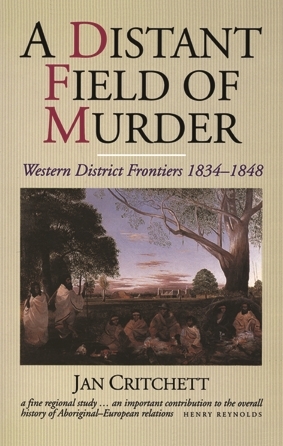 |
Jan Critchett A Distant Field of Murder: Western District Frontiers 1834–1848 Melbourne University Press, 1990, first published 1988, first paperback edition 1992′A Distant Field of Murder tells the frontier story of south-western Victoria during the 1830s and 1840s. In vivid details it describes how one culture, that of the original possessors of the land, responded to the catastrophe visited upon it by white settlers. It reveals the complexity of the settlement process, the choices confronting the newcomers as they struggled to establish themselves. It expresses the dilemmas faced by the colonial administration attempting to maintain a fragile peace.This detailed examination of one region explores events of national significance, an immense human drama with consequences which remain with us to this day.’ Melbourne University Press |
 |
Roger Milliss Waterloo Creek: The Australia Day massacre of 1838, George Gipps and the British conquest of New South Wales McPhee Gribble, 1992, 1994A number of editions of this book exist, in print and as an e-book. The cover shown is that of the 1994 print edition.’Australia Day, January 26, 1838. On a remote stream in northern New South Wales soon known as Waterloo Creek, a party of Mounted Police and convict stockmen under Major J. W. Nunn marks the occasion by massacring up to 300 Aborigines. Late in February a new Governor, George Gipps, arrives determined to introduce a new deal for the Aborigines and orders an inquiry into the atrocity. Three months later, stockmen in the same area slaughter twenty-eight Aborigines at Henry Dangar’s Myall Creek station. Gipps has the perpetrators rounded up and in December 1838 seven of them are hanged, the first time in the colony’s history whites have paid the supreme penalty for killing blacks.The white backlash sends Gipps reeling. The Waterloo Creek inquiry proceeds in obscurity, ending in the complete exoneration of Nunn and his troopers. Step by step, Gipps abandons his humanitarian policy towards the blacks under the relentless pressure of the squatters for permanent tenure of the land they have seized from its indigenous owners. Waterloo Creek is a comprehensive and intricately drawn account of the dramatic events of 1838, against the background of the fate of the Aborigines of south-eastern Australia generally in the first fifty years of the European invasion. At its centre is the story of the whites’ rapacious grabbing of the land. In its pursuit, morality and law are disregarded, the well-meaning Gipps broken and humiliated, and genocide committed, condoned and even encouraged.’ McPhee Gribble |
1990
 |
Michael Cannon Who Killed the Koories?: The true terrible story of Australia’s founding years William Heinemann Australia, 1990‘Who Killed the Koories? is about the good and the evil that co-exist in the hearts of human beings, no matter what the colour of their skin. The setting is the Australian frontier, specifically the Port Phillip district of New South Wales in the 1840s. Here some of the darkest deeds which have ever stained the pages of our history took place–out of sight, out of mind, until this penetrating examination of concealed records brings them pulsing back to life.The truth about many white pioneers, and their black opponents, is simply too frightful to remain suppressed forever. Now at last, Michael Cannon reveals the full story of days of greed, heroism, passion and death on the wide Australian landscape.’ William Heinemann Australia |
1981
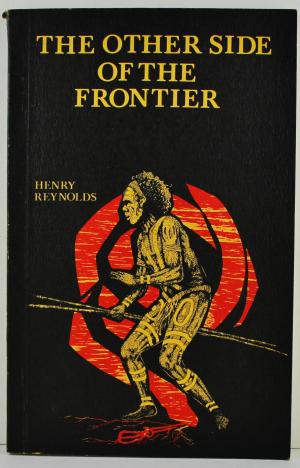 |
Henry Reynolds The Other Side of the Frontier: An interpretation of the Aboriginal response to the invasion and settlement of Australia History Department, James Cook University, Townsville, 1981’The publication of “The Other Side of the Frontier” in 1981 profoundly changed the way in which we understand the history of relations between indigenous Australians and European settlers. It has since become a classic of Australian history. Drawing from documentary and oral evidence, the book describes in meticulous and compelling detail the ways in which Aborigines responded to the arrival of Europeans. Henry Reynolds’ argument that the Aborigines resisted fiercely was highly original when it was first published and is no less challenging today.’ University of New South Wales Press, summary to revised edition 2006 |
Compiled by Jane Morrison 2012–2021. Updated November 2021. Latest updates 14 November 2021, 30 November 2021, 18 April 2022, 5, 28 October 2022, 8 November 2022, 11 June 2024, 7 May 2025, 7 July 2025.


